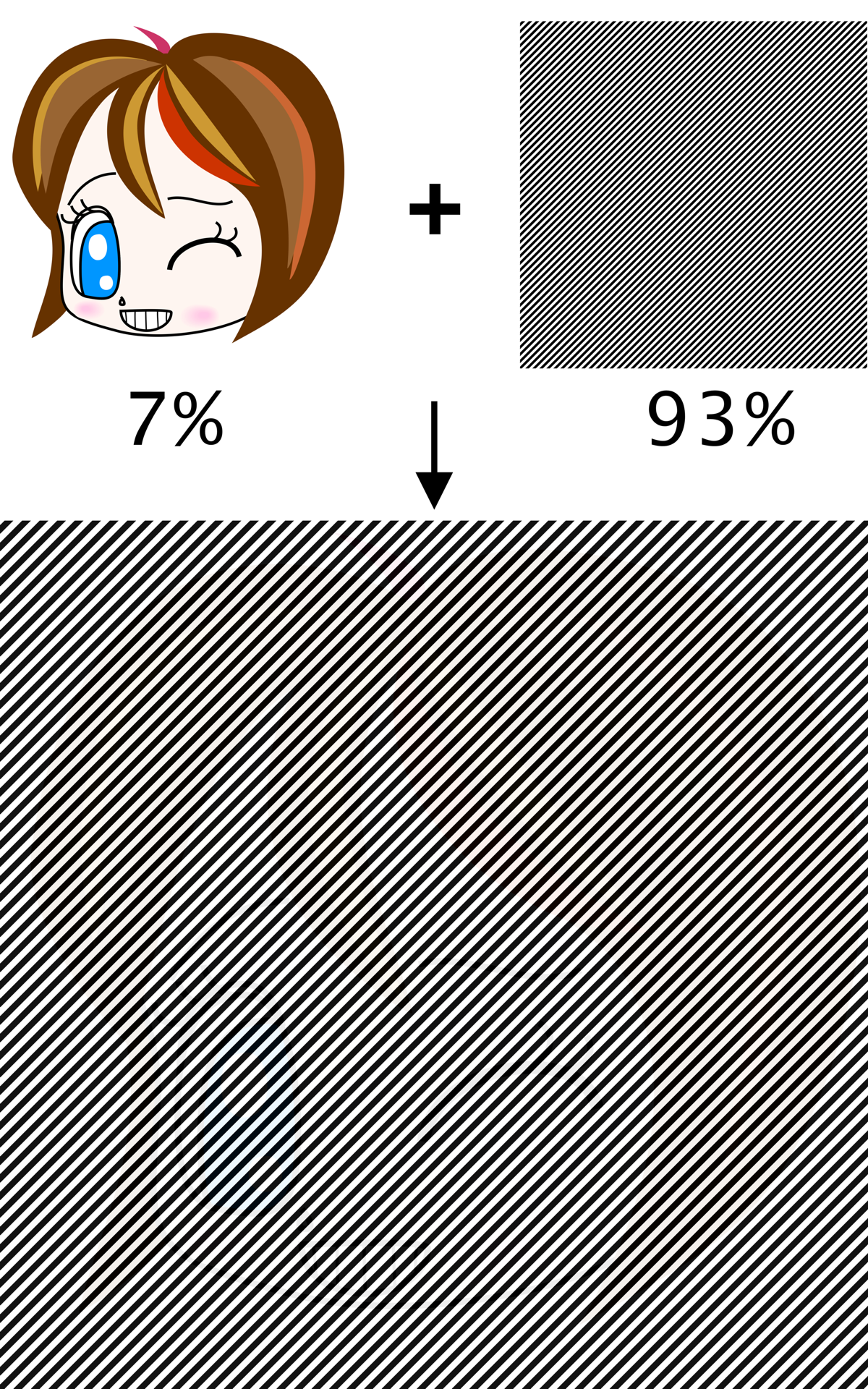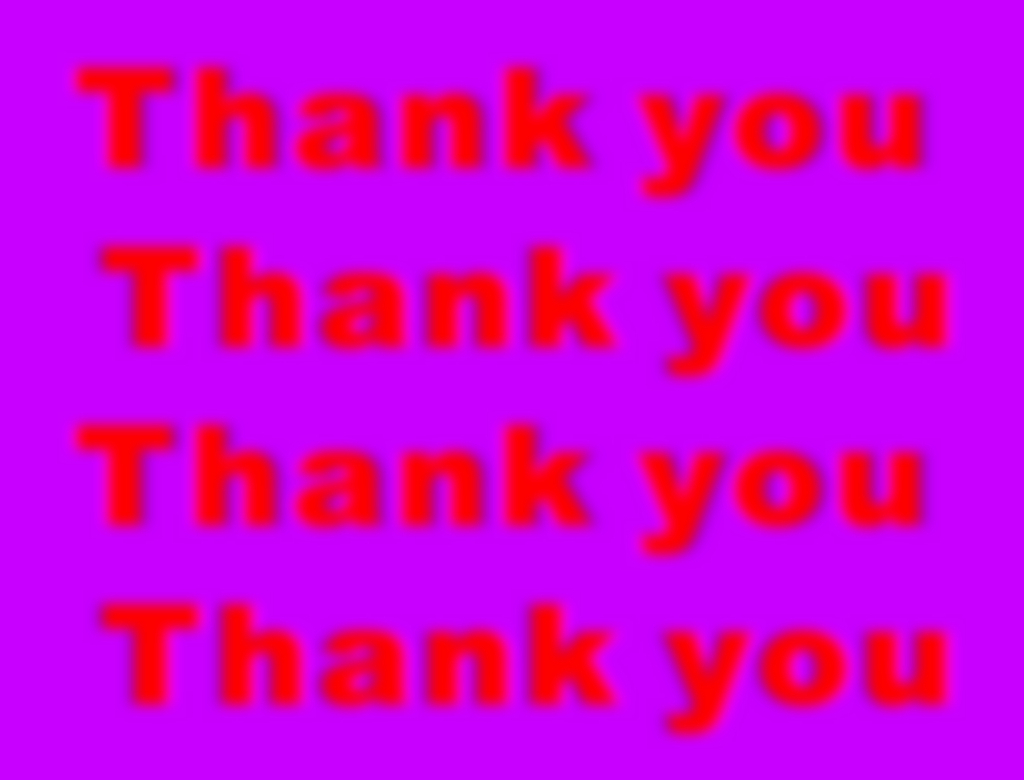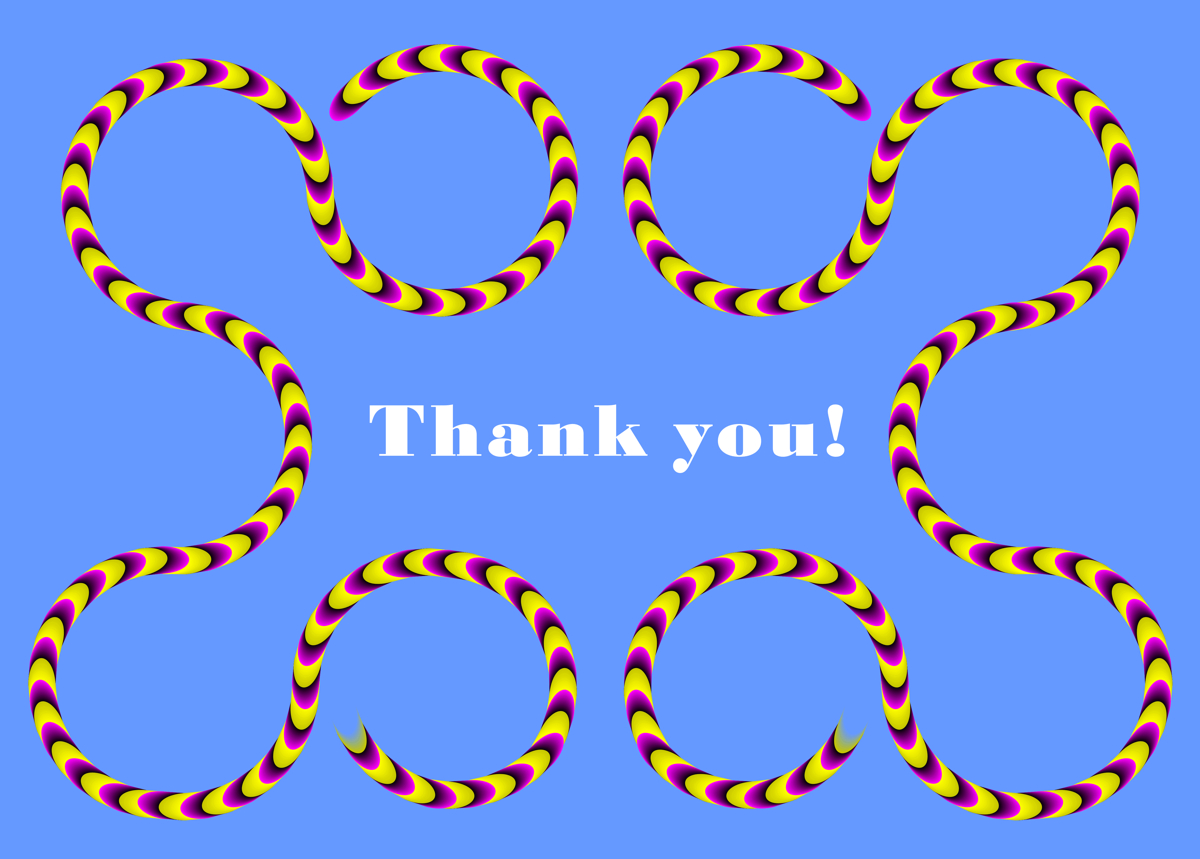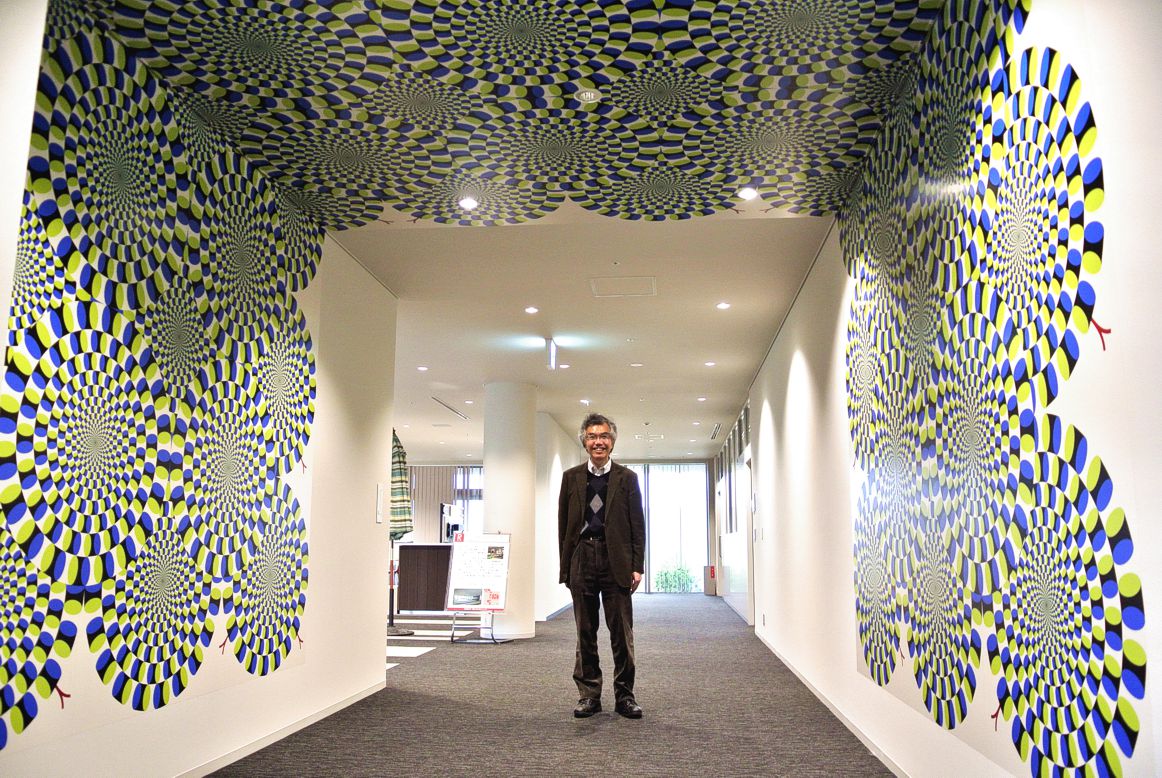
February 29, 2024, 10:00-11:00?
OIC B棟5階・クロノトポス
錯視研究の紹介
北岡明佳(立命館大学総合心理学部)email
Since February 28 Handout
OIC(立命館大学大阪いばらきキャンパス)にようこそお越し頂きました!!

Illusion Galary @ Ritsumeikan University Osaka-Ibaraki Campus, Osaka, Japan
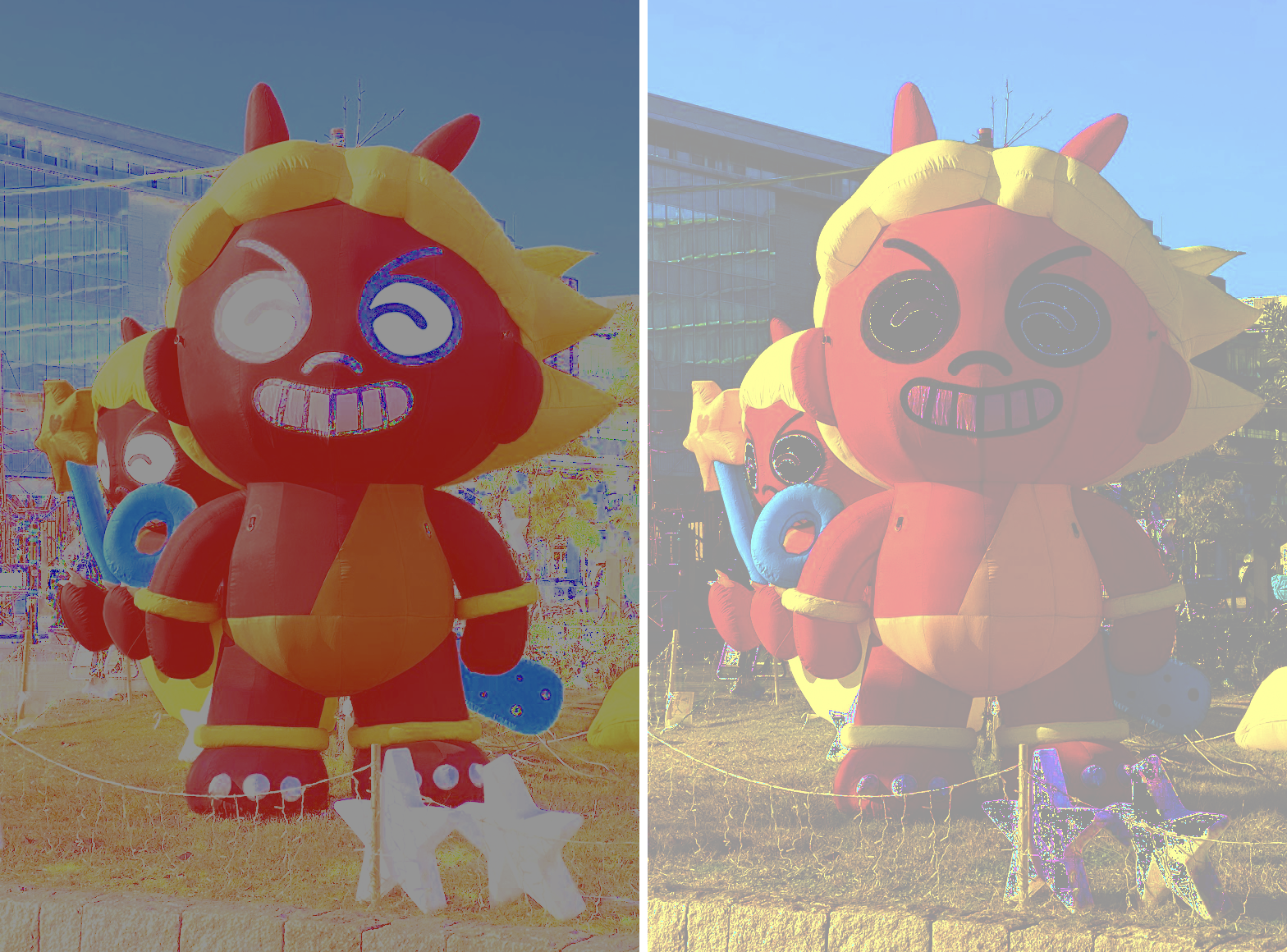
「茨木童子の白目と黒目」
左の茨木童子の「白目」(白目なのか??)は白く、右のそれは黒く見えるが、同じ輝度(R149, G149, B149)である。
Copyright Akiyoshi Kitaoka 2023 (December 31)
Today's talk
1. Classic geometrical illusions
2. My illusions or works (18 pieces)
3. Lightness constancy and lightness illusions
4. Color constancy and color illusions
5. Shape constancy and depth illusions
6. Q & A
1. Classic geometrical illusions

Classic geometrical illusions. (a) Müller-Lyer illusion. The lower horizontal line segment appears to be longer than the upper one, though they are the same length. (b) Ebbinghaus illusion (Titchener illusion). The right circle surrounded by smaller ones appears to be larger than the left circle surrounded by larger ones, though they are the same size. (c) Ponzo illusion. The upper line segment appears to be longer than the lower one, though they are the same length. The left circle appears to be larger than the right one, though they are the same size. (d) Poggendorff illusion. Line segments appear to be misaligned, though they are actually aligned. (Φ denotes the empty set) (e) Zöllner illusion. Oblique black lines appear to tilt alternately, though they are parallel to each other. (f) Hering illusion. The two horizonal lines appear to curve. (g) Münsterberg illusion (Café Wall illusion). Gray horizontal lines appear to tilt alternately. (h) Fraser illusion. Stripes drawn obliquely appear to tilt alternately, though they are parallel to each other. (i) Spiral illusion (of the Fraser illusion). Concentric circles appear to be spirals.

(d) Poggendorff illusion (classic T-type). Line segments appear to be misaligned, though they are actually aligned.
Links to my classic SNS addess.  (https://twitter.com/AkiyoshiKitaoka)
(https://twitter.com/AkiyoshiKitaoka)
2. My illusions or works
No. 1 in popularity
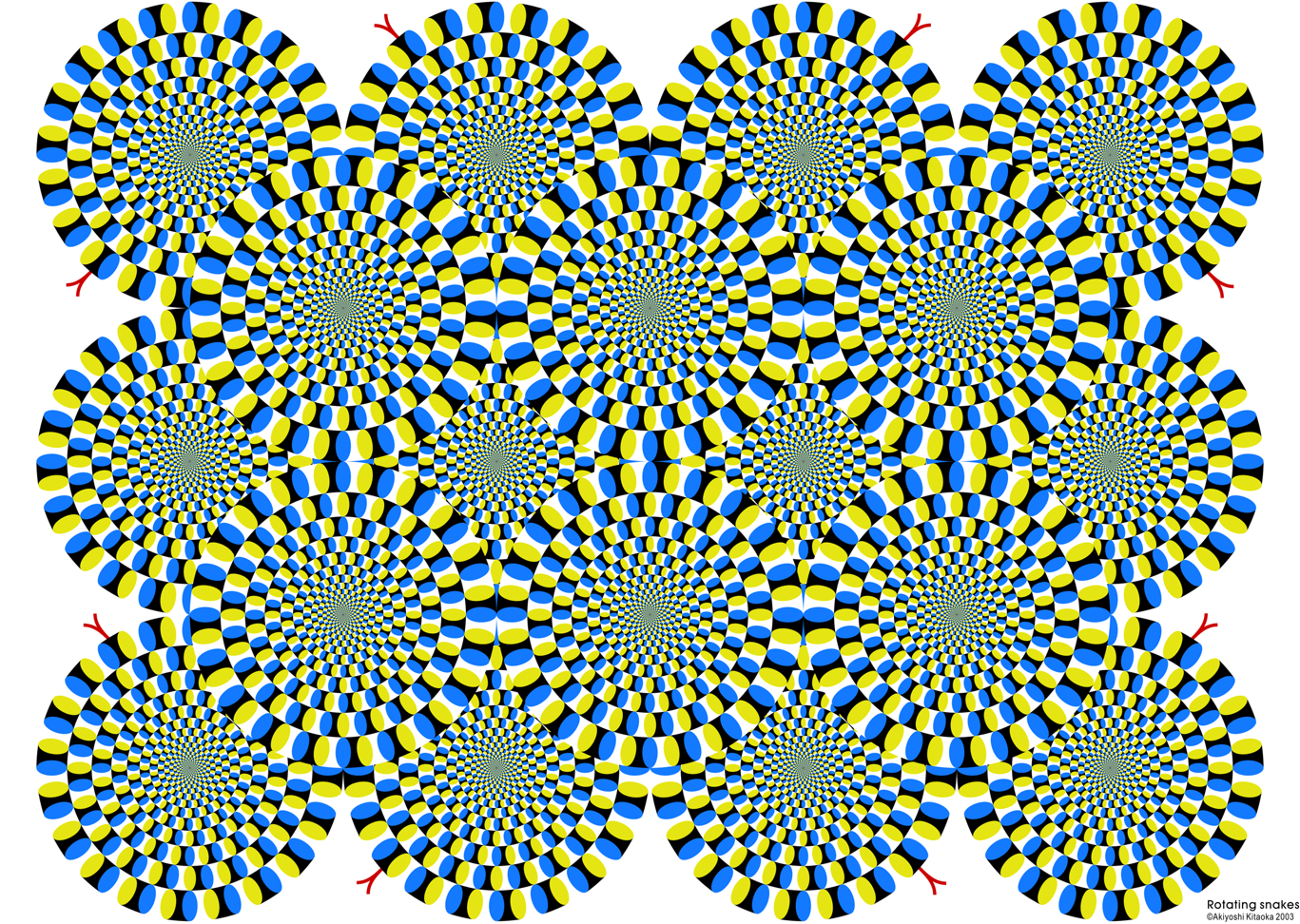
"Rotating snakes"
Disks appear to rotate.
Copyright Akiyoshi Kitaoka 2003
Kitaoka, A. (2017). The Fraser-Wilcox illusion and its extension. A. G. Shapiro and D. Todorović (Eds.), The Oxford Compendium of Visual Illusions, Oxford University Press, pp. 500-511. PDF --- Figures --- PDF (scanned copy)
No. 2
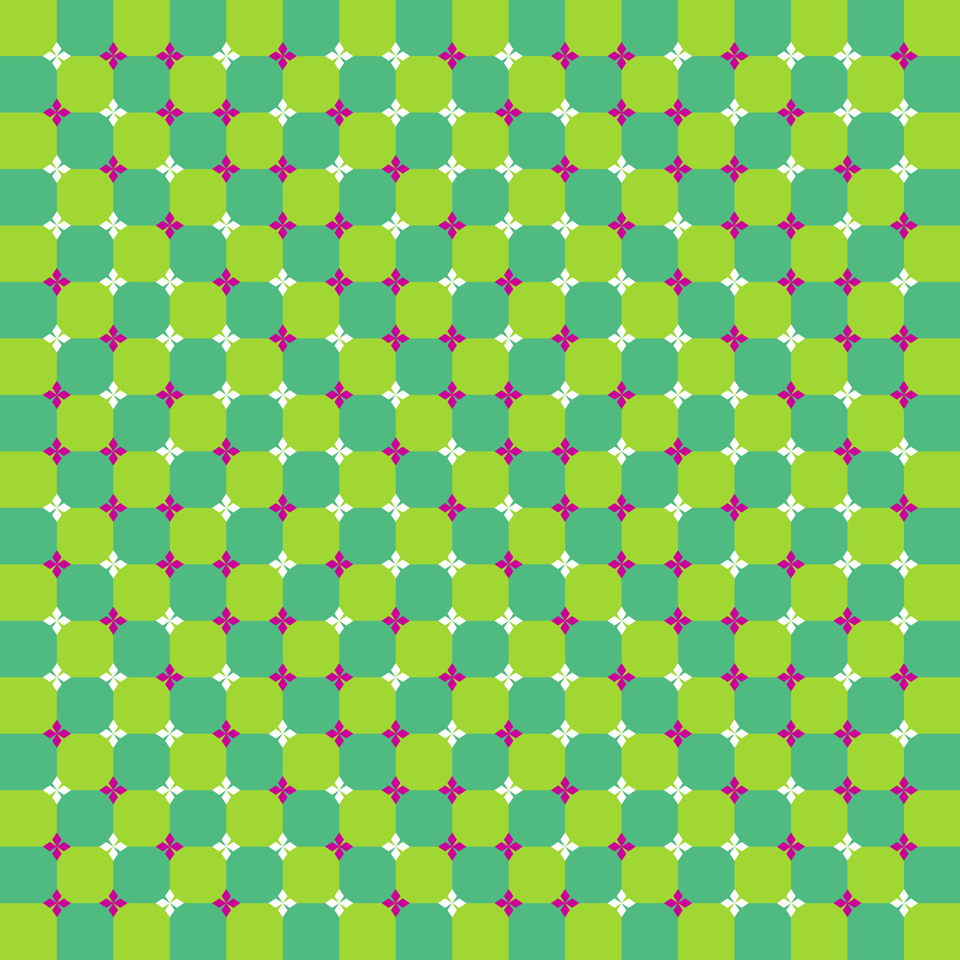
"Primrose field"
The image appears to wave.
Copyright Akiyoshi Kitaoka 2002
No. 3
"Green and blue spirals"
There appear to be spirals of light green or light blue. Actually, they are identical (r = 0, g = 255, b = 150).
Copyright A.Kitaoka 2003
No. 4
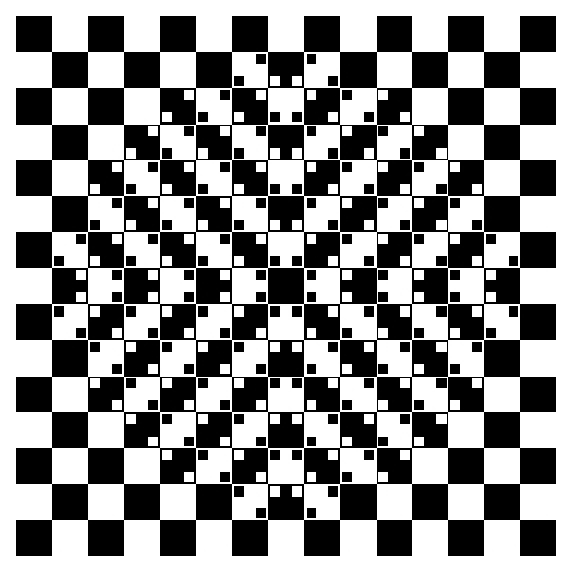
"A bulge"
The floor appears to bulge out, though this image consists of only squares.
Copyright A.Kitaoka 1998
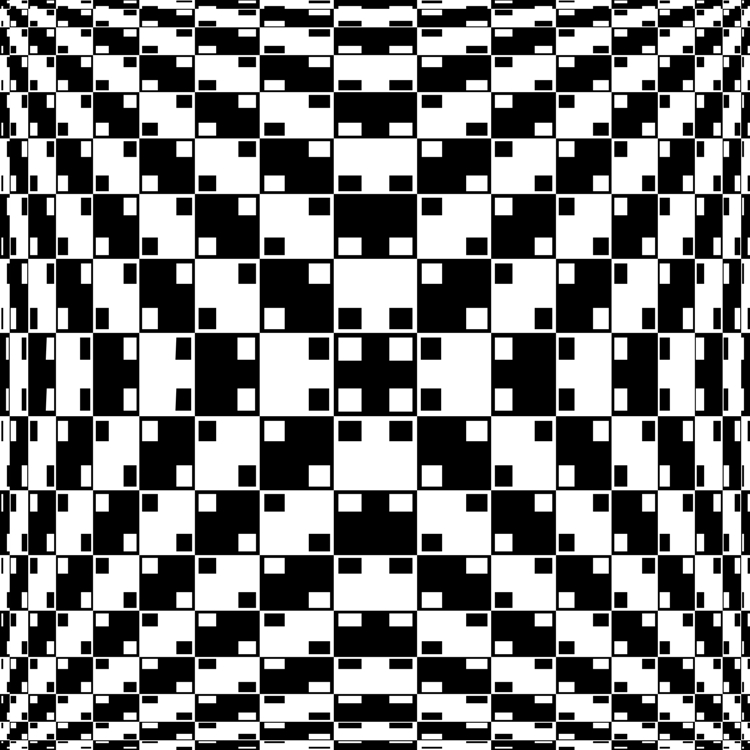
"Cushion"
This image appears to bulge out, though it consists of squares and rectangles aligned vertically or horizontally.
Copyright A.Kitaoka 1998
No. 5
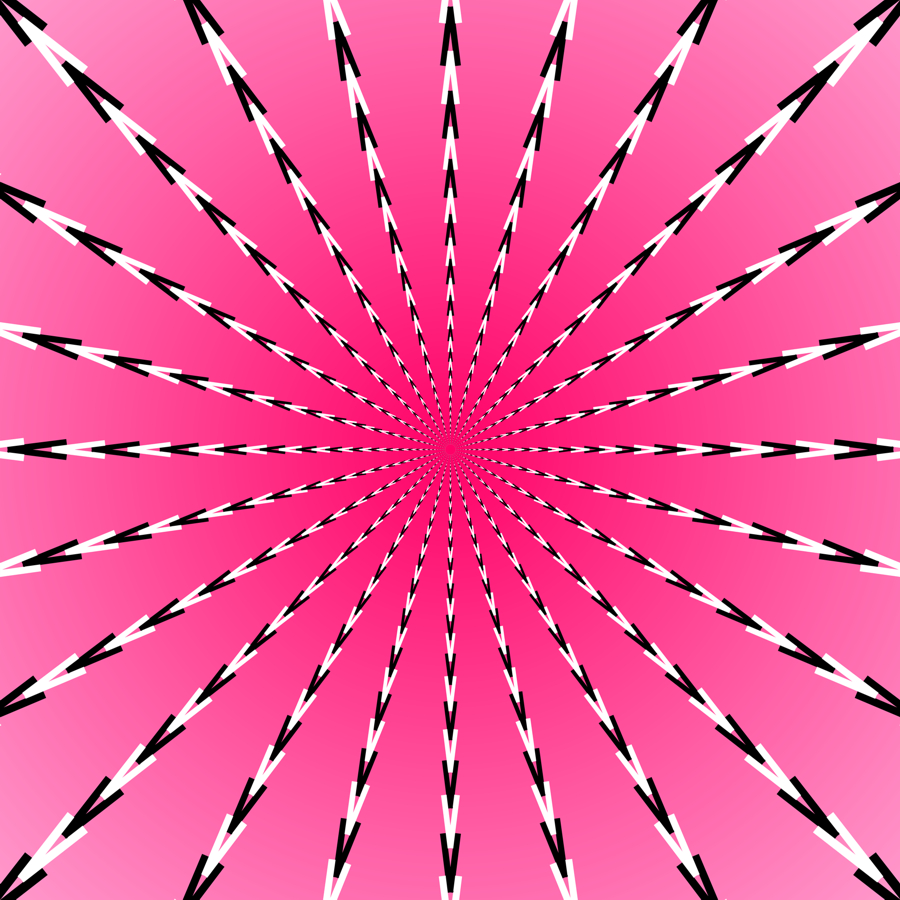
"Hatpin urchin (pink)"
The image appears to wiggle in the radial direction.
Copyright Akiyoshi Kitaoka 2013 (November 19)
No. 6
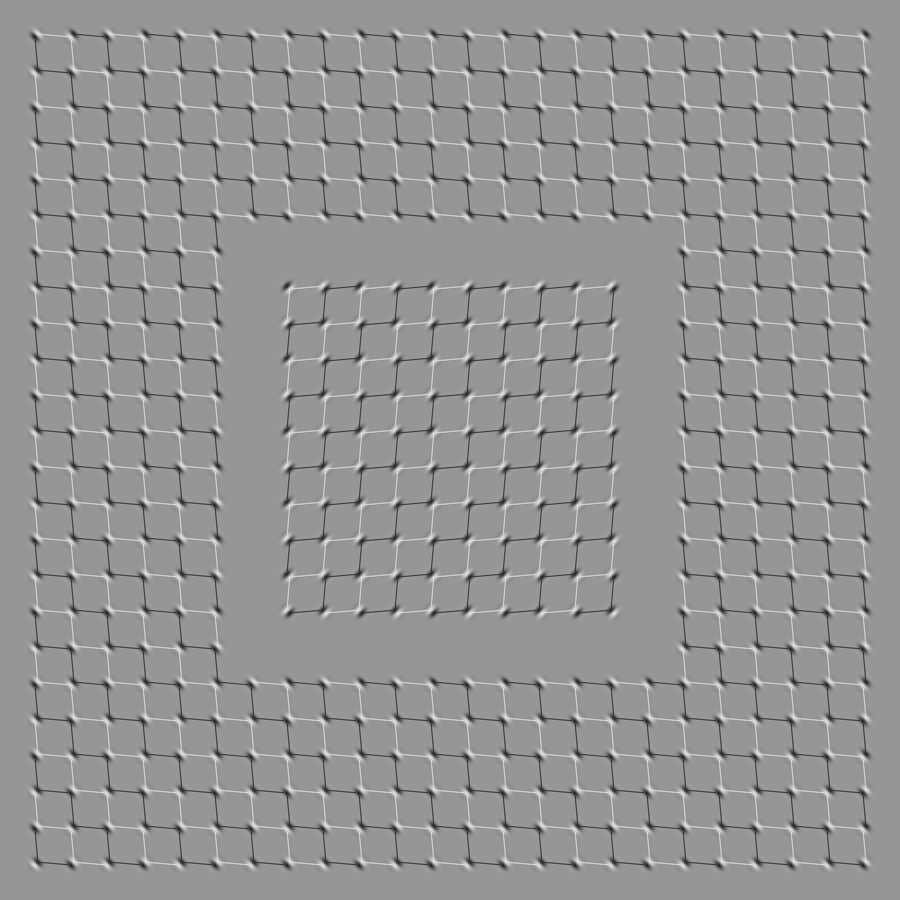
"Drifting Emboss illusion"
(sine type)
The inset appears to move.
Copyright Akiyoshi Kitaoka 2016 (February 15)
Recently popular 1
Differences in perceived speed pic.twitter.com/V42VxQDRZ3
— Akiyoshi Kitaoka (@AkiyoshiKitaoka) February 4, 2020
知覚速度自由自在 pic.twitter.com/lHMg6Bv7oG
— Akiyoshi Kitaoka (@AkiyoshiKitaoka) December 19, 2019
Recently popular 2
"Illusory reddish coke can"
The Coca-Cola can appears to be reddish, though it consists of black and white stripes.
Copyright Akiyoshi Kitaoka 2021 (October 13)
Recently popular 3
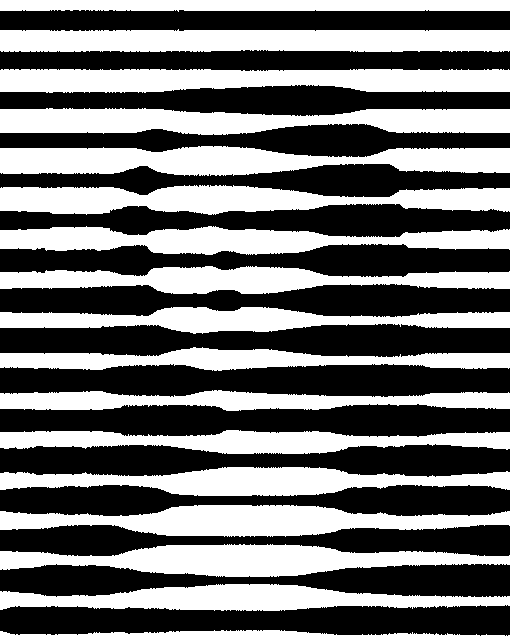
"Who am I?"
This is a intensely degraded image, but it can be perceived as it is (Mona Lisa).
Copyright Akiyoshi Kitaoka 2022 (January 30)
Recently popular 4
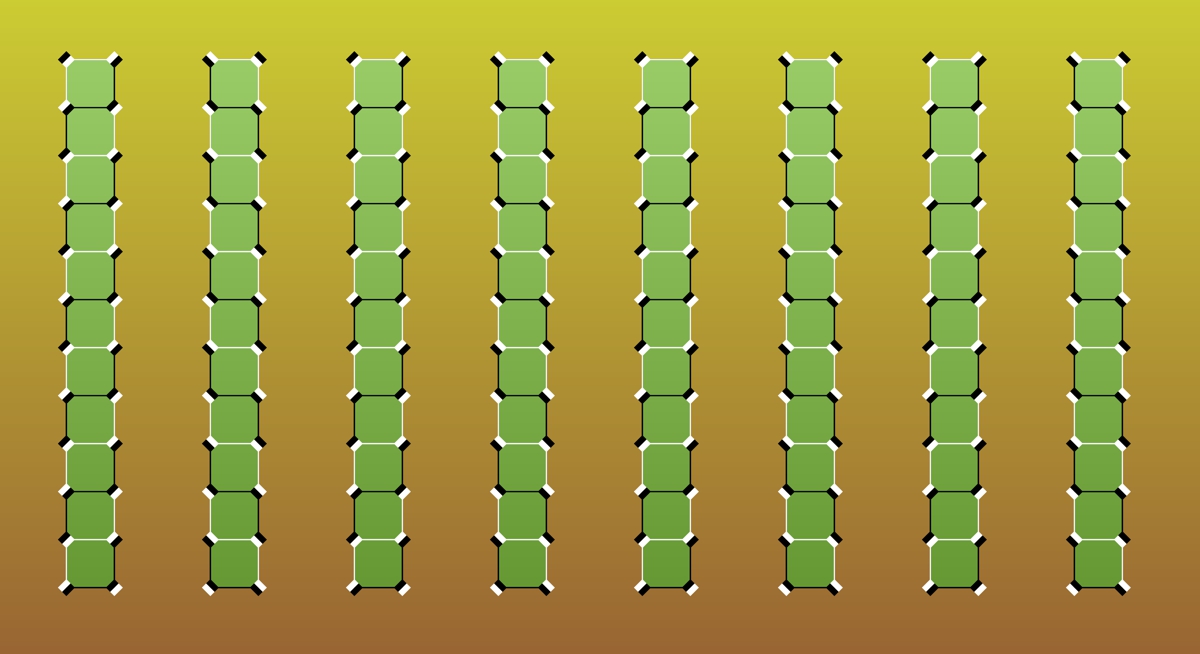
"Bamboos"
Columns appear to move.
Copyright Akiyoshi Kitaoka 2014 (January 5)
Sometimes popular 1
(additive color change version)
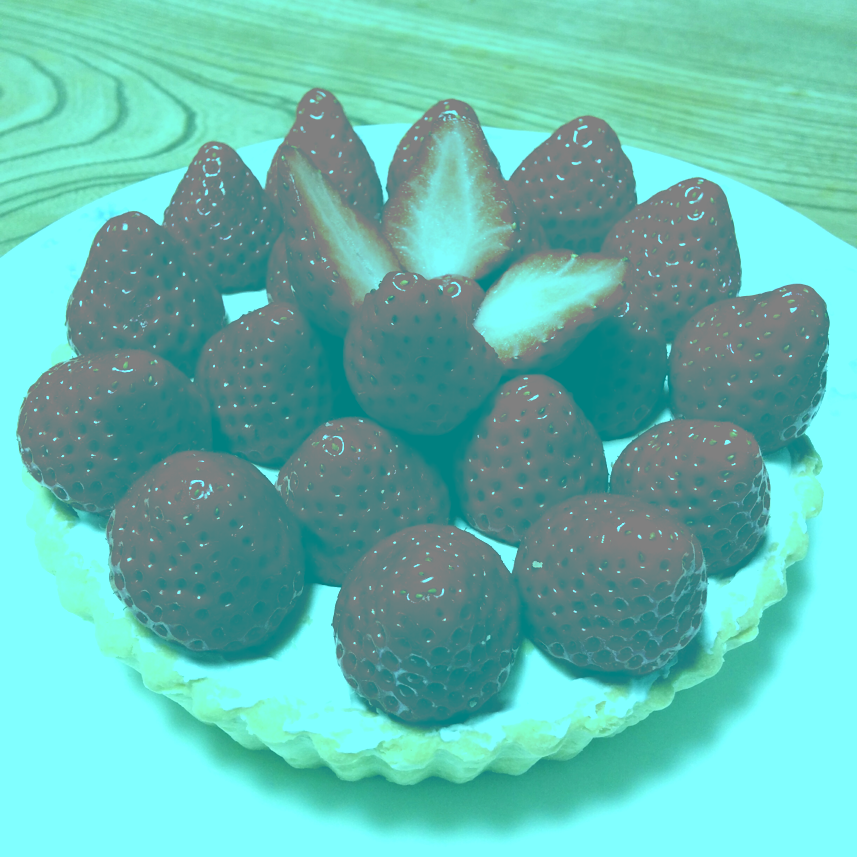
Edwin Land's two-color method version
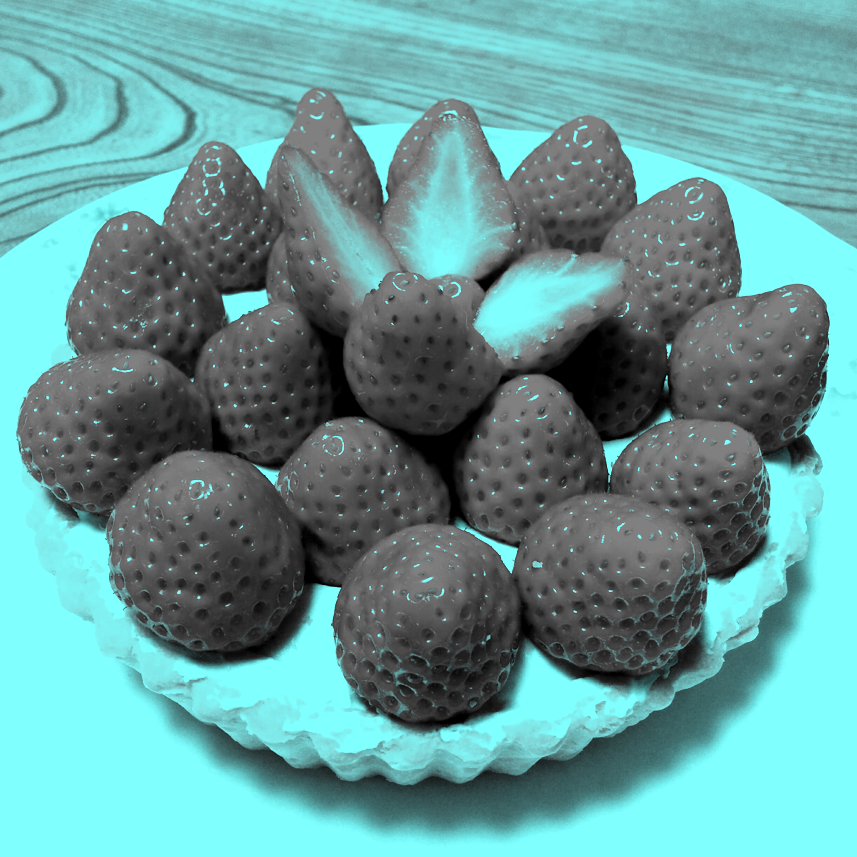
Strawberries appear to be reddish, though the pixels are not.
Sometimes popular 2
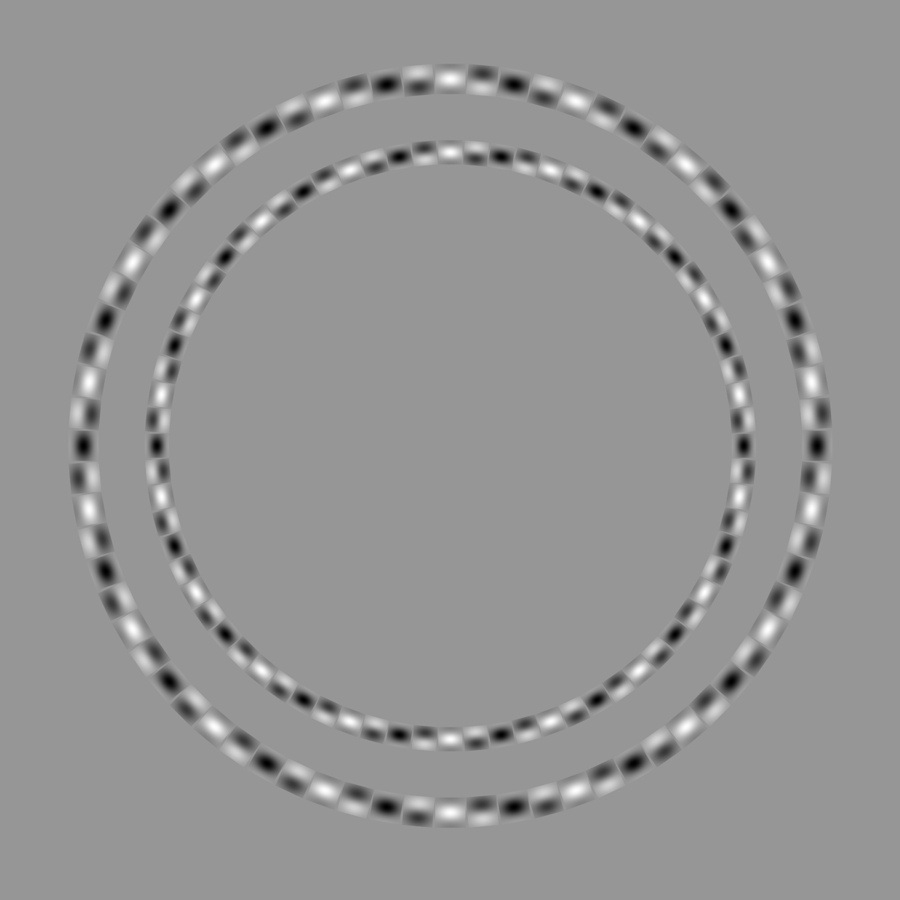
"Entangling illusion"
The two concentric rings appear to be entangled.
Copyright Akiyoshi Kitaoka 2019 (May 1)
Sometimes popular 3
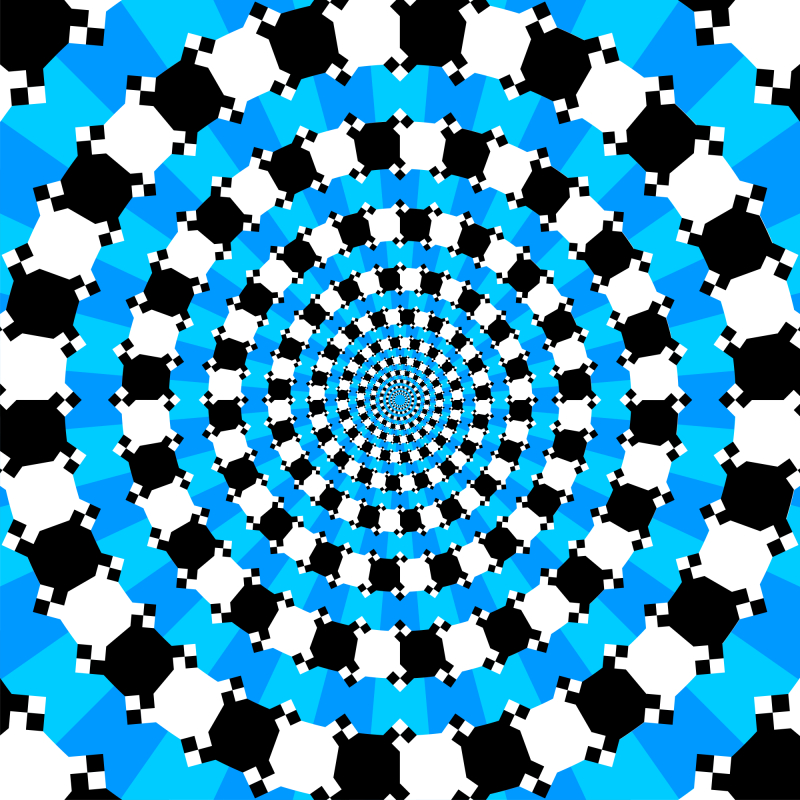
"Water spirals"
Concentric rings appear to be spirals.
Copyright Akiyoshi Kitaoka 2009 (March 3)
Sometimes popular 4
Some observer sees red in front of blue, and another observer sees blue in front of red. pic.twitter.com/zg4eDTkWCL
— Akiyoshi Kitaoka (@AkiyoshiKitaoka) November 14, 2019
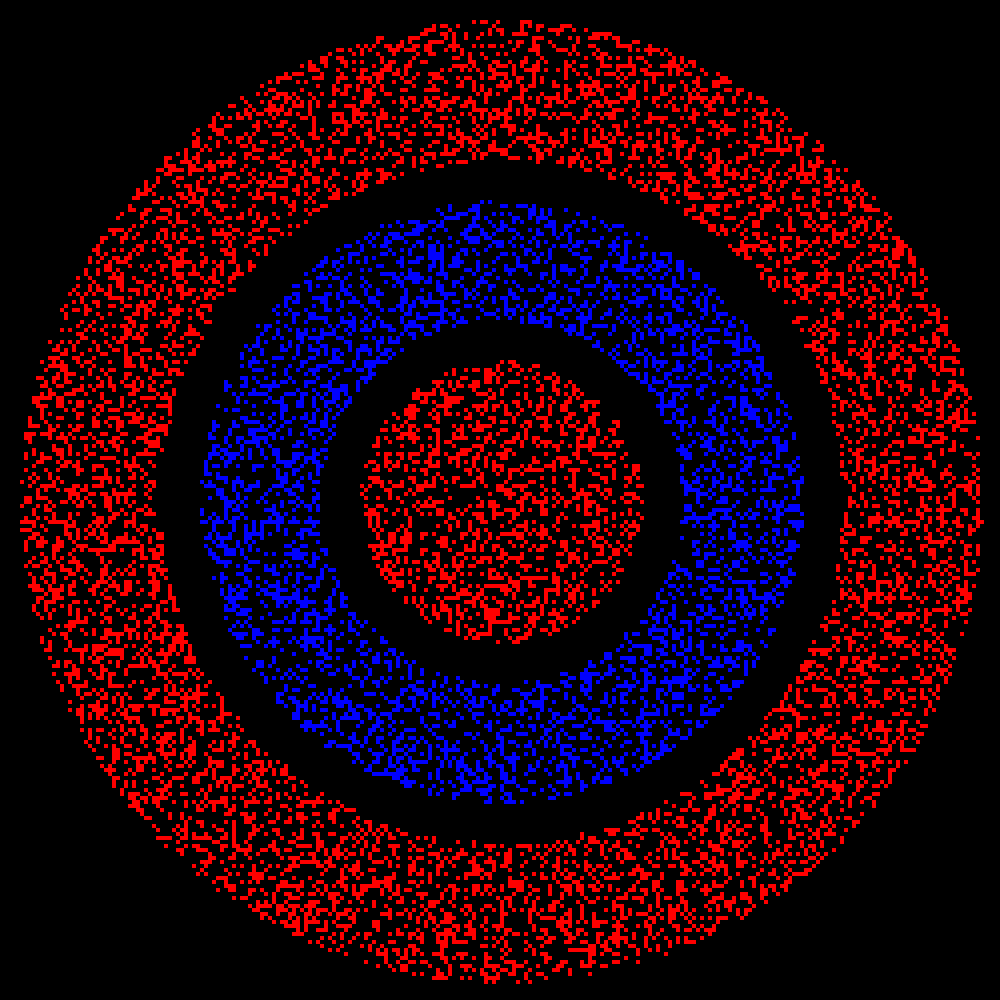
Chromostereopsis
Sometimes popular 5
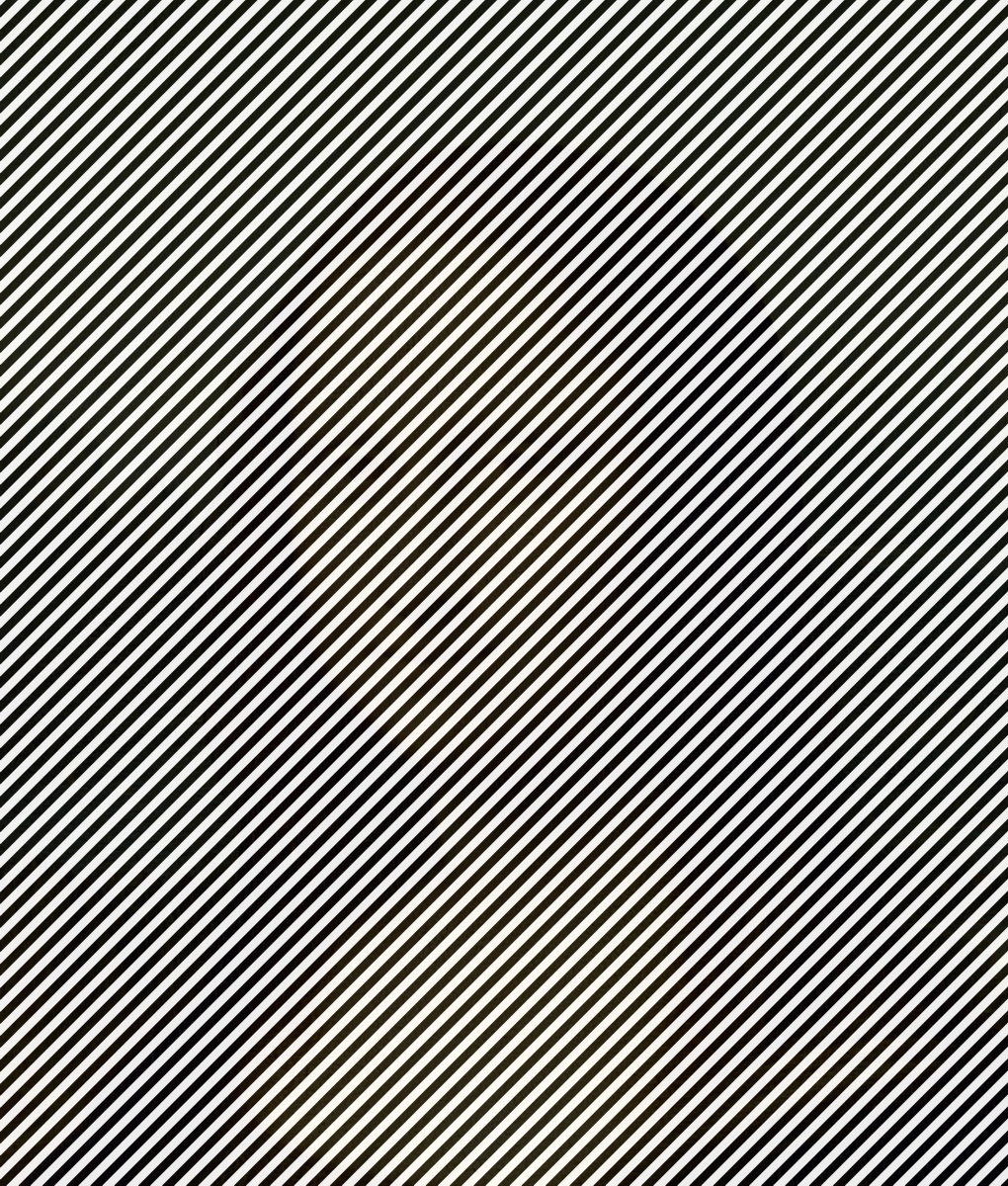
Mona Lisa is hidden. She is visible when you squint, when you move the image, or when you contract the image.
My favorite 1
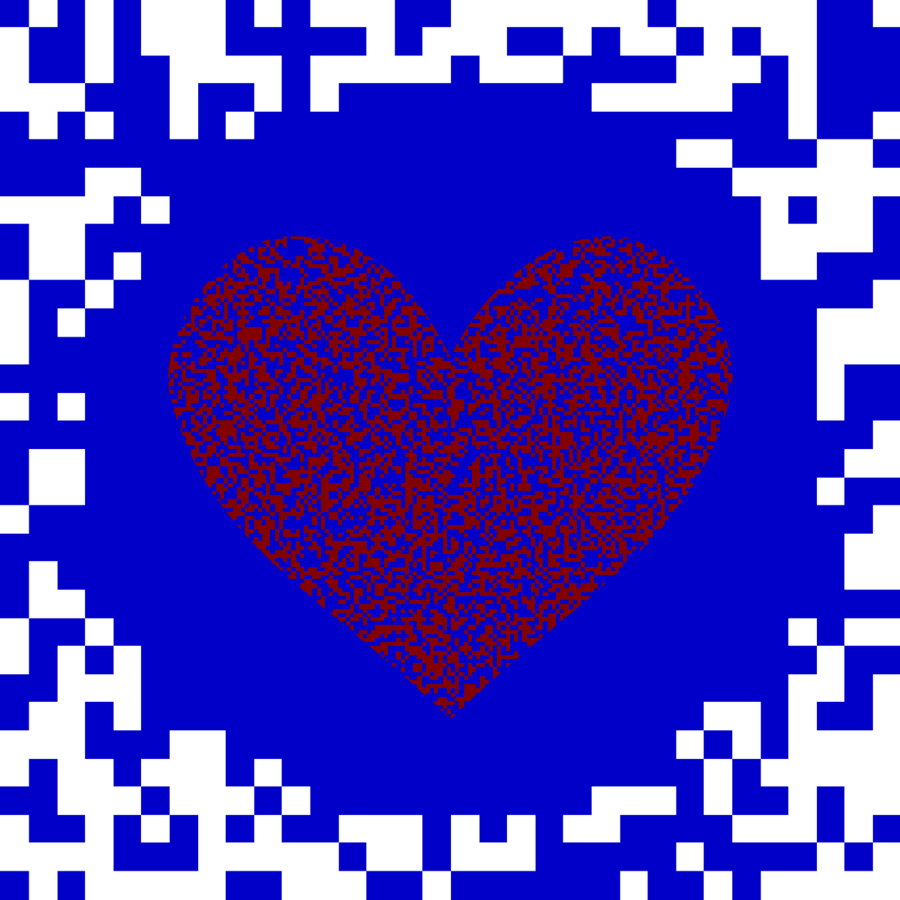
"kind of fluttering heart"
The heart apepars to move when the image is swayed.
Copyright Akiyoshi Kitaoka 2019 (September 23)
My favorite 2

"A train that runs with its doors open"
A train appears to move rightward.
Copyright Akiyoshi Kitaoka 2021 (February 9)
北岡明佳 (2021) 「輝度変化による運動錯視(リバースファイなど)の再検討」 (2021年3月2日(火)15:40~16:20・第15回錯覚ワークショップ(Zoom Webinar)) Presentation (html)
Amazing illusion (not my illusion but a popular demo I made) 1
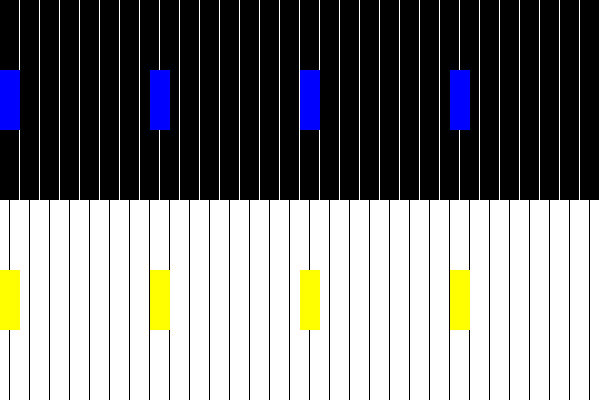
A demo of the kickback illusion
Rectangles appear to wobble when caught in vertical lines, though they move coherently at a constant speed.
Copyright Akiyoshi Kitaoka 2021 (August 17)
Howe, P. D. L., Thompson, P. G., Anstis, S., Sagreiya, H., & Livingstone, M. S. (2006). Explaining the footsteps, belly dancer, Wenceslas and kickback illusions. Journal of Vision, 6, 1396–1405. doi: 10.1167/6.12.5
Kitaoka, A. & Anstis, S. (2021). A review of the footsteps illusions. Journal of Illusion, 2, #5612, 1-22. PDF --- Website --- https://doi.org/10.47691/joi.v2.5612 --- Movies and figures
Amazing illusion (not my illusion but a popular demo I made) 2
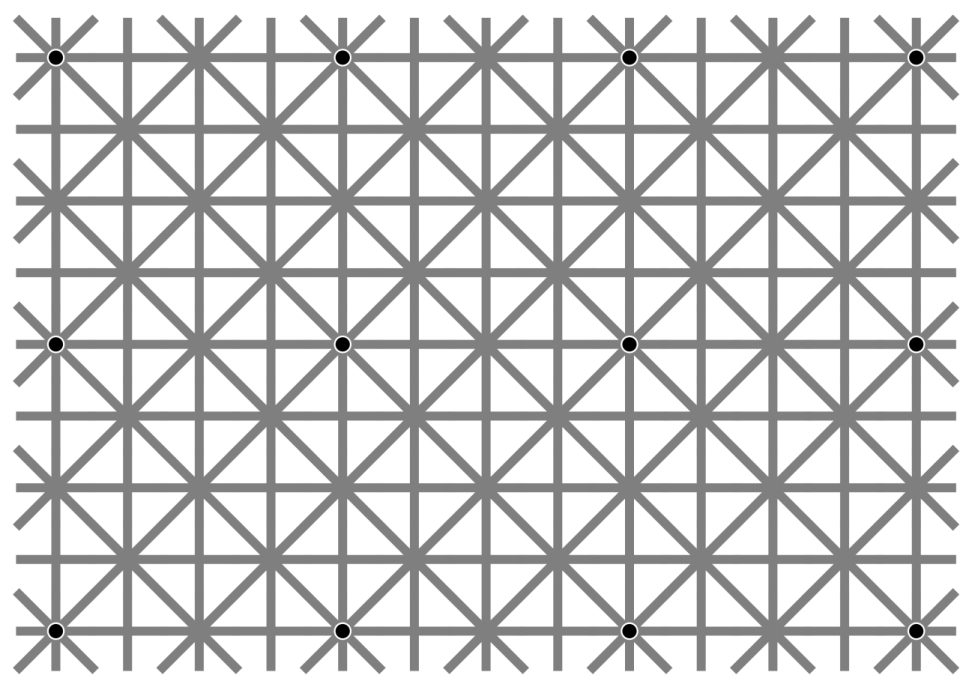
"Ninio's extinction illusion"
There are twelve dots at crosses, but only a few dots are visible simultaneously.
Ninio, J. & Stevens, K. A. (2000). Variations on the Hermann grid: an extnction illusion. Perception, 29, 1209-1217.
2. Lightness constancy and lightness illusions
Lightness constancy is a perceptual phenomenon that allows us to perceive the lightness (black, white, or gray) of objects as relatively stable and consistent, despite changes in the lighting or filtering conditions under which they are viewed.
Original image

Images of transparent (darkened) transformation (left) and of translucent
(whitened) transformation (right)
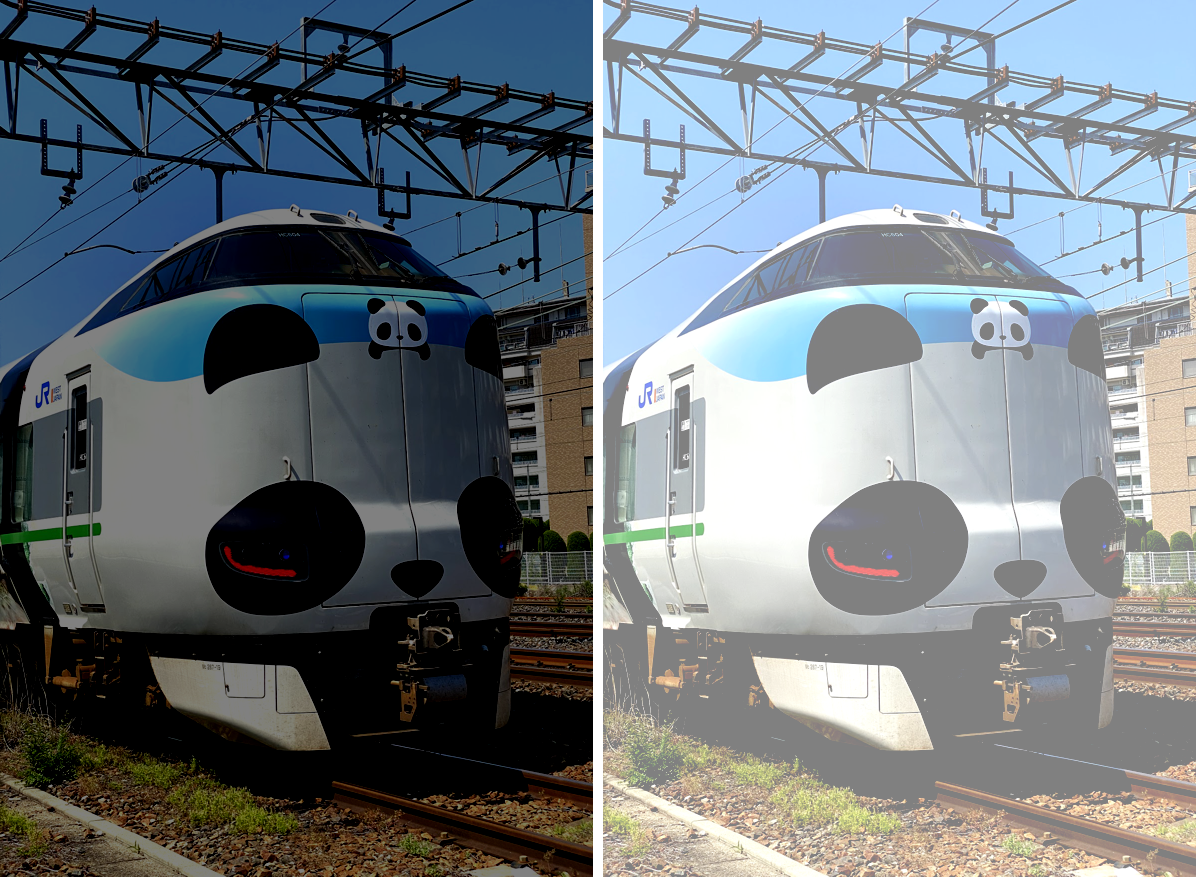
The white part of the left image is the same luminance as the black part of the right image.
Let's check the colors.
another example
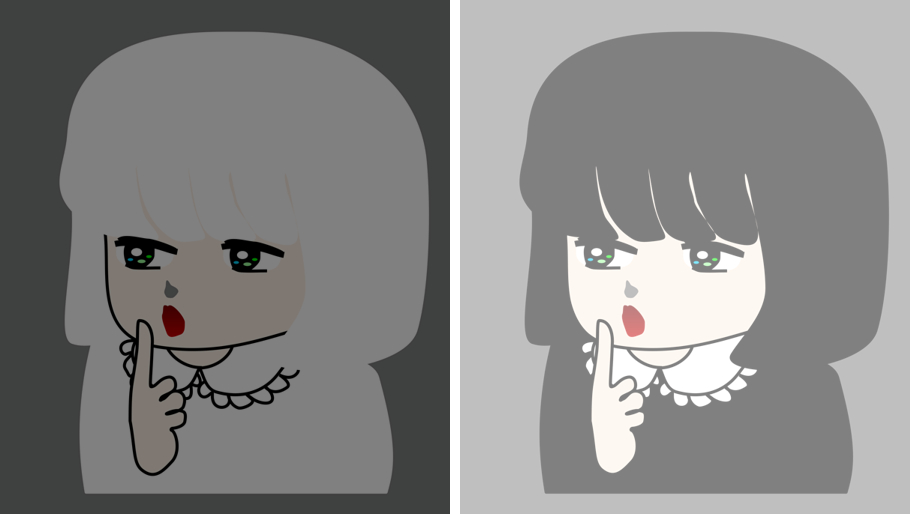
The hair and clothes of the left image is the same luminance as those of the right image.
cf. checkershadow illusion (Adelson)
In natural images, RGB sub-pixel values are distributed from minimum to maximum, although with some bias.
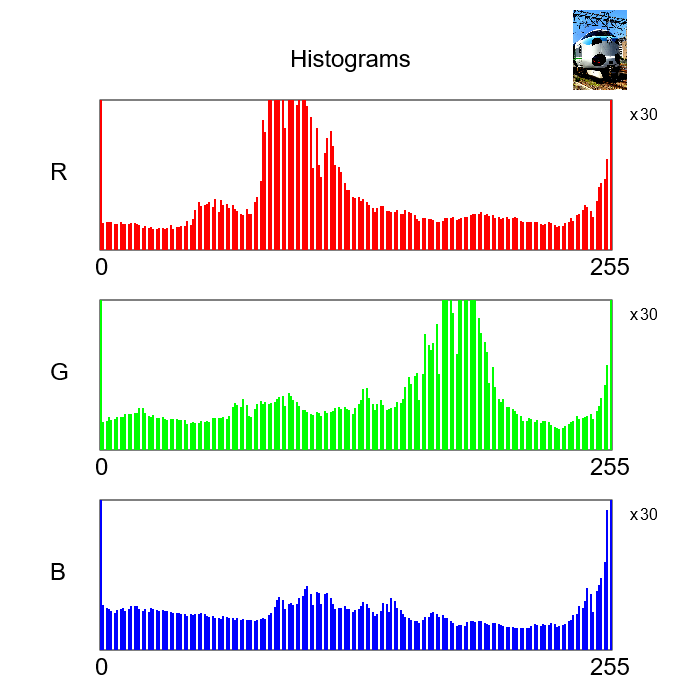
For the image of transparent (darkened) transformation, RGB sub-pixel values are distributed from minimum to intermediate values.
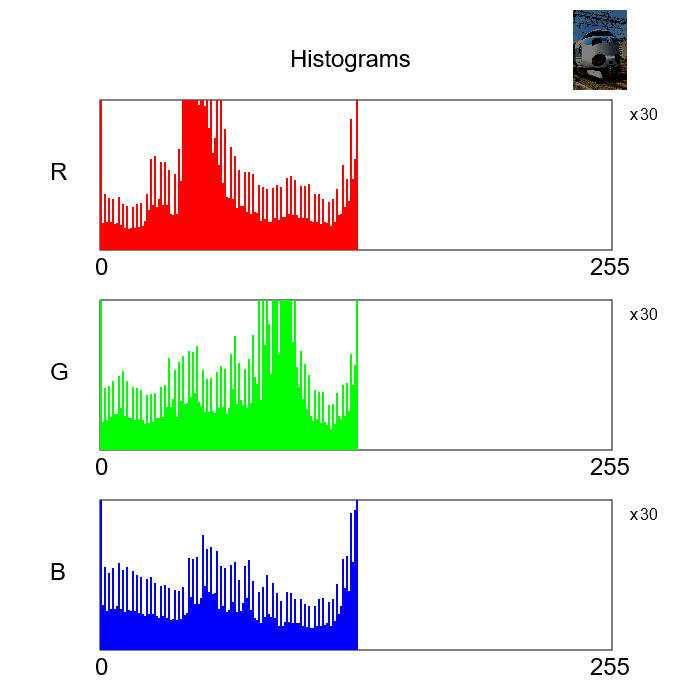
For the image of translucent (whitened) transformation, RGB sub-pixel values are distributed from intermediate values to maximum.
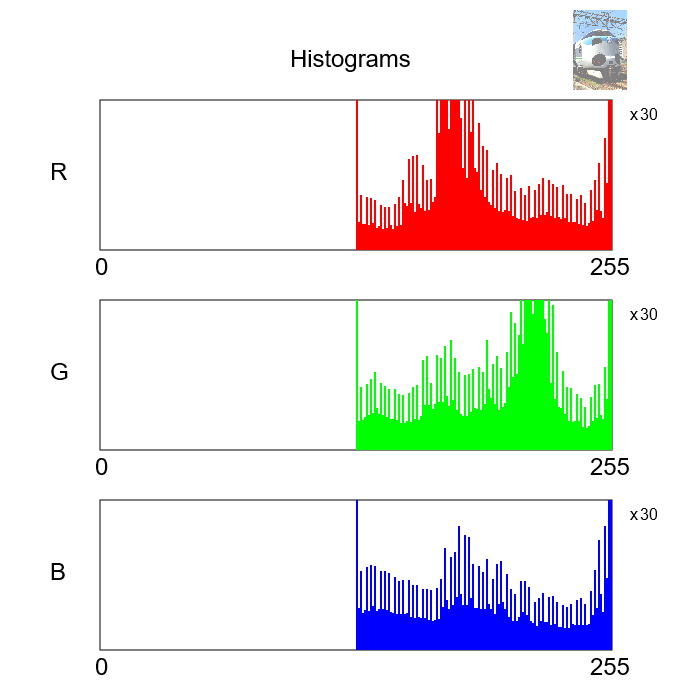
How can we recover the original image from those transformed images? This is achieved by transforming or expanding the distribution of RGB sub-pixel values to the range from minimum to maximum. We assume that a similar function is present in human perception and realizes lightness constancy.
This idea is called "histogram equalization" proposed by Shapiro et al. (2018).
Shapiro, A., Hedjar, L., Dixon, E., and Kitaoka, A. (2018). Kitaoka's tomato: Two simple explanations based on information in the stimulus. i-Perception, 9(1), January-February, 1-9. PDF (open access)
3. Color constancy and color illusions
Color constancy is a perceptual phenomenon that allows us to perceive the color (red, green, blue, etc.) of objects as relatively stable and consistent, despite changes in the lighting or filtering conditions under which they are viewed.
Original image
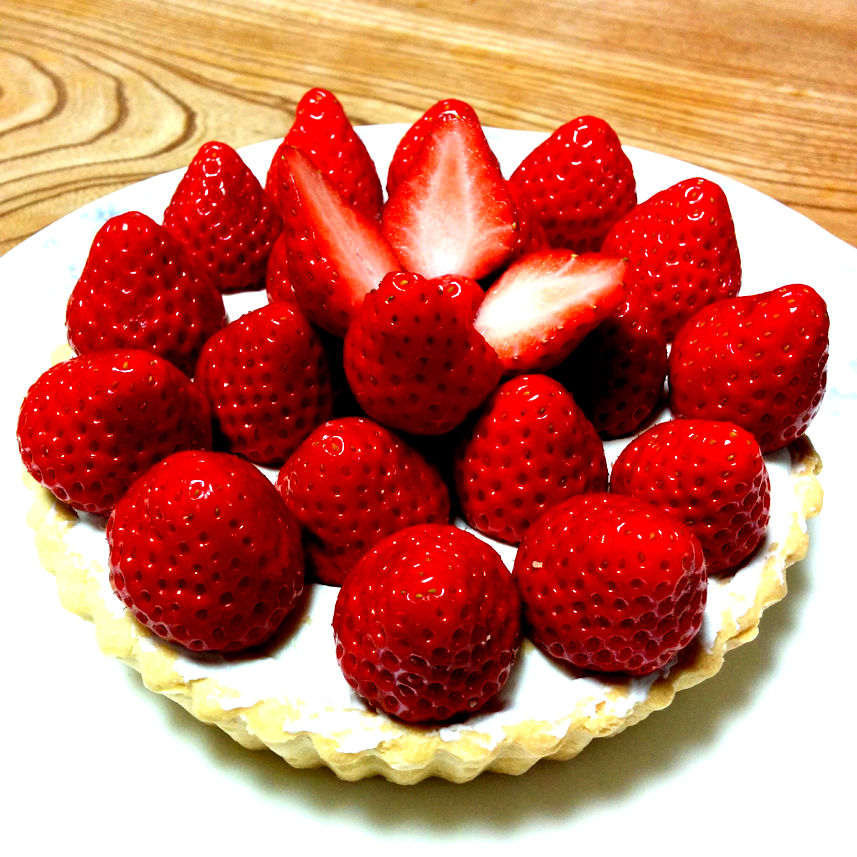
An image of translucent transformation (additive color change)

Let's check the colors.
In natural images, RGB sub-pixel values are distributed from minimum to maximum, although with some bias.
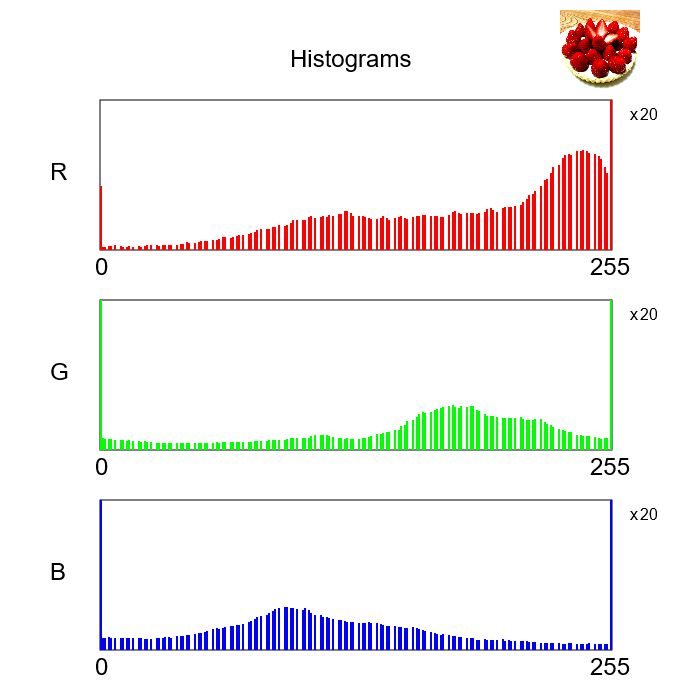
For the image of translucent (whitened) transformation, RGB sub-pixel values are distributed from intermediate values to maximum.

Plotted into the CIE xy chromaticity diagram. '+' shows the white point (D65).
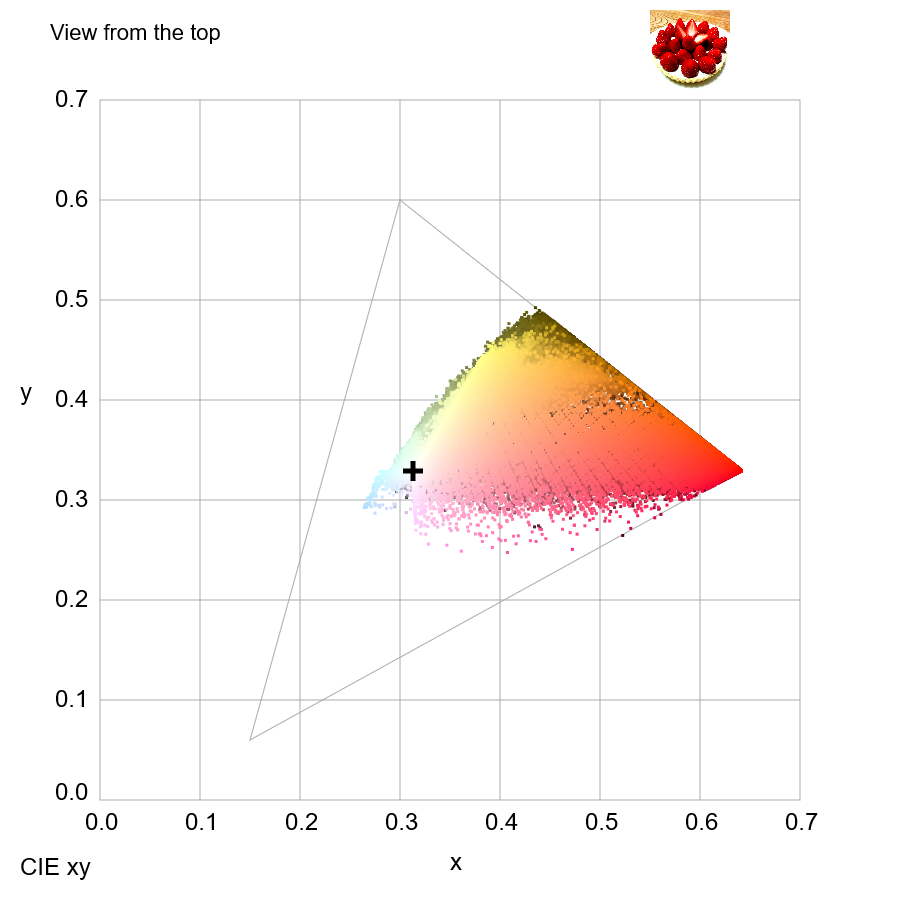
Plotted into the CIE xy chromaticity diagram. '+' shows the white point (D65). There are no reddish pixels.

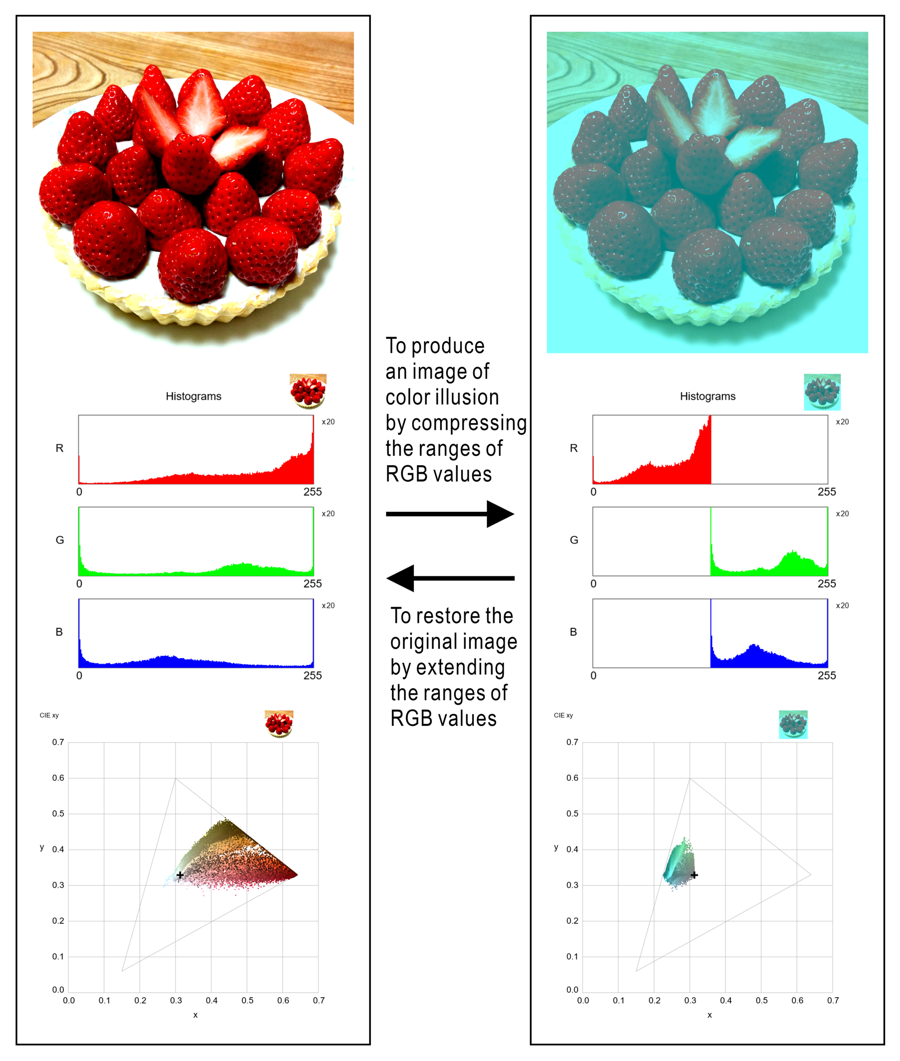
Copyright Akiyoshi Kitaoka 2022 (April 14)
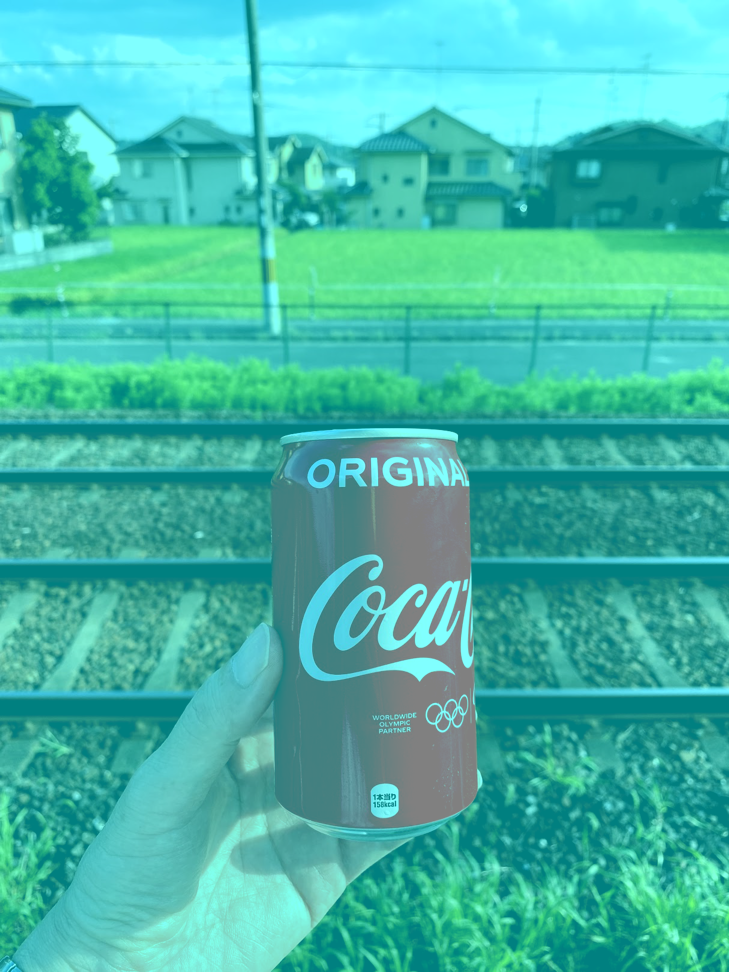
"Illusory reddish coke can"
The Coca-Cola can appears to be reddish, though the pixels are not.
Copyright Akiyoshi Kitaoka 2023 (March 11)

Society for Applied Research in Memory and Cognition
AIMS
The Society for Applied Research in Memory and Cognition is dedicated to encouraging and promoting the very best research in our field. The purpose of the Society is to enhance collaboration and co-operation between basic and applied researchers in memory and cognition. Every two years, we showcase the latest work in a wide and varied program that's sure to intrigue you. SARMAC is also known for our active, friendly community. If you're not a member, we hope you join us.
Reference http://www.sarmac.org/about/aims-and-origin
Q: The strawberries and the Coca-Cola can look red because we remember that they are red, right?
(Q: Memory color or not?)
Related reference
Duncker, K. (1939). The influence of past experience upon perceptual properties.
The American Journal of Psychology, 52, 255–265.
https://doi.org/10.2307/1416111
Hansen, T., Olkkonen, M., Walter, S., & Gegenfurtner, K. R. (2006).
Memory modulates color appearance. Nature Neuroscience, 9, 1367–1368.
https://doi.org/10.1038/nn1794
A: Probably wrong. The effect of memory color, if any, would not play a major part.
This is because the color illusion occurs similarly even if the color is not typical of the object.
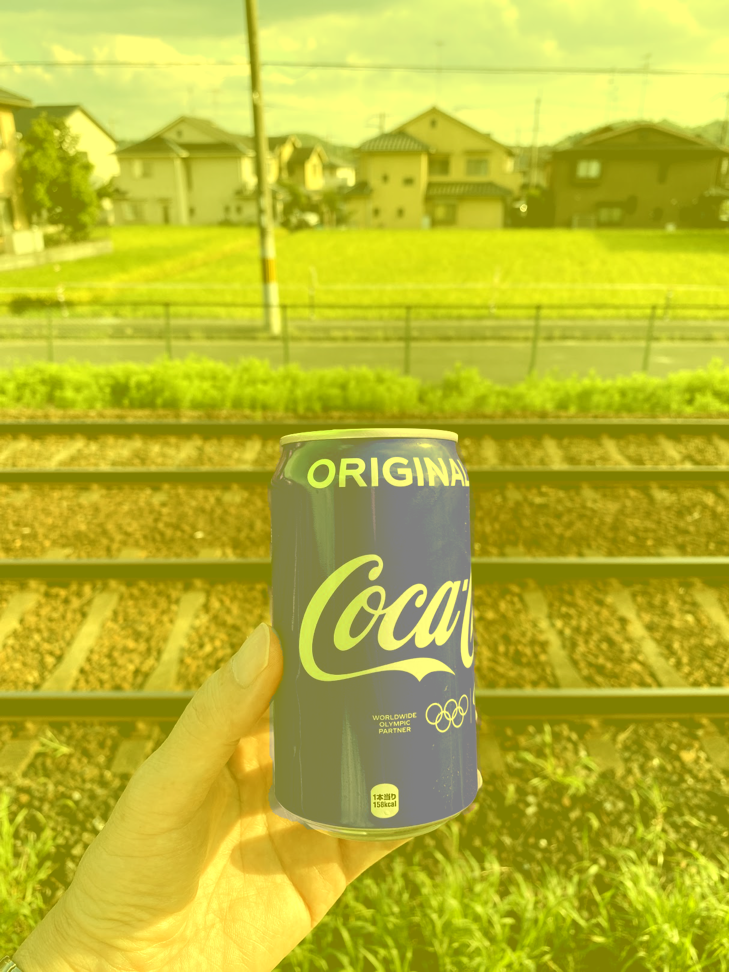
"Illusory bluish coke can"
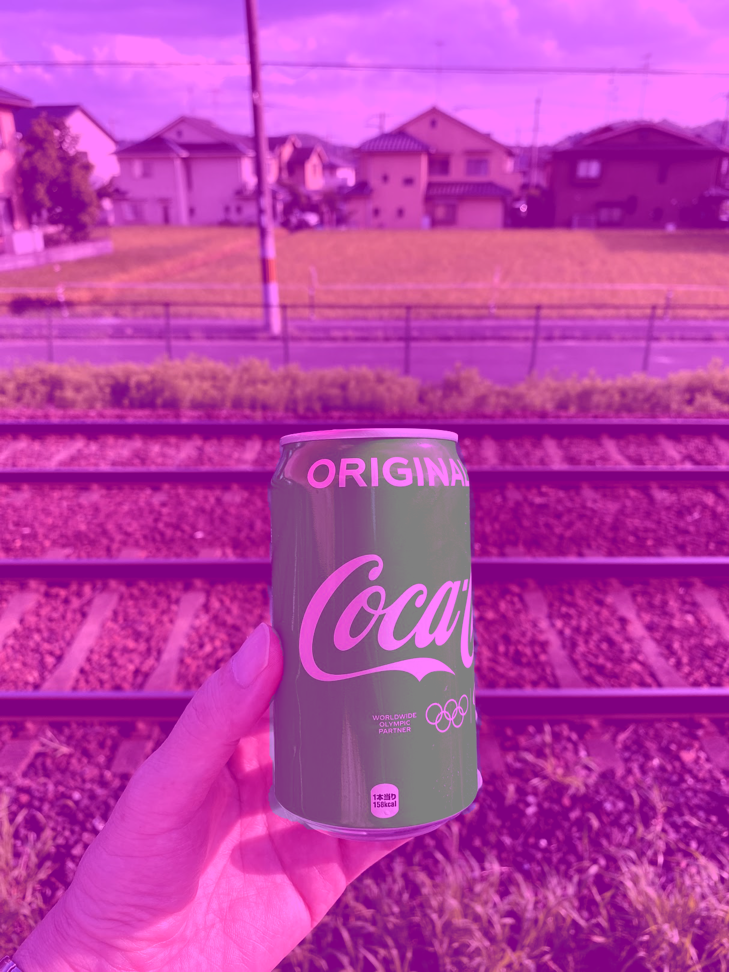
"Illusory greenish coke can"
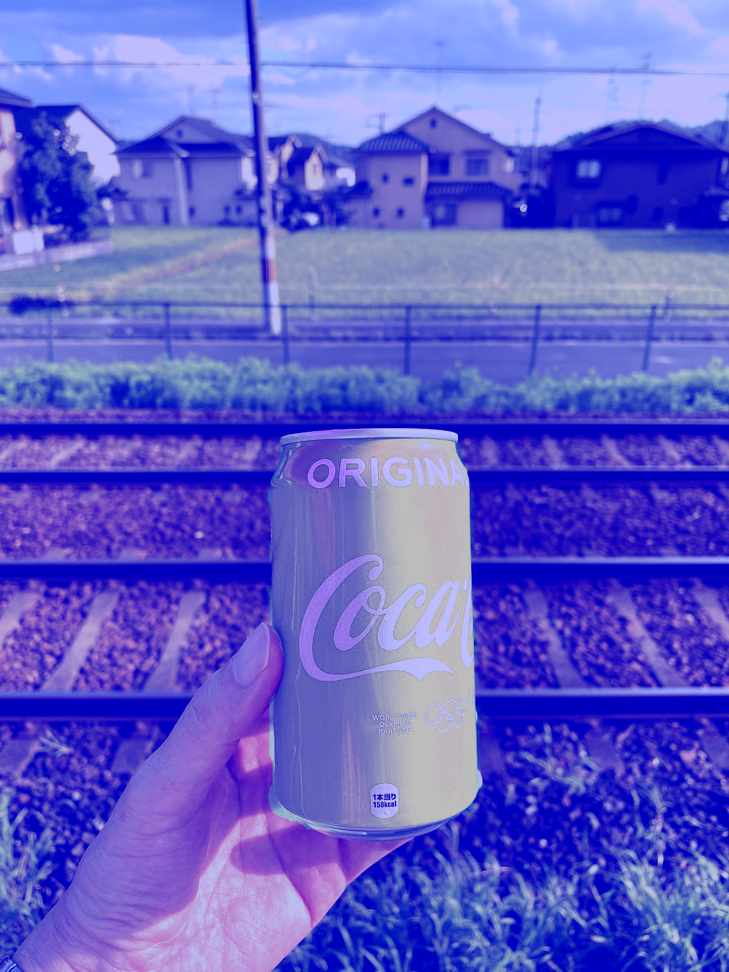
"Illusory yellowish coke can"

"Illusory bluish strawberries"

"Illusory greenish strawberries"

"Illusory yellowish strawberries"
This color illusion (based upon color constancy) can be applied to graphics.
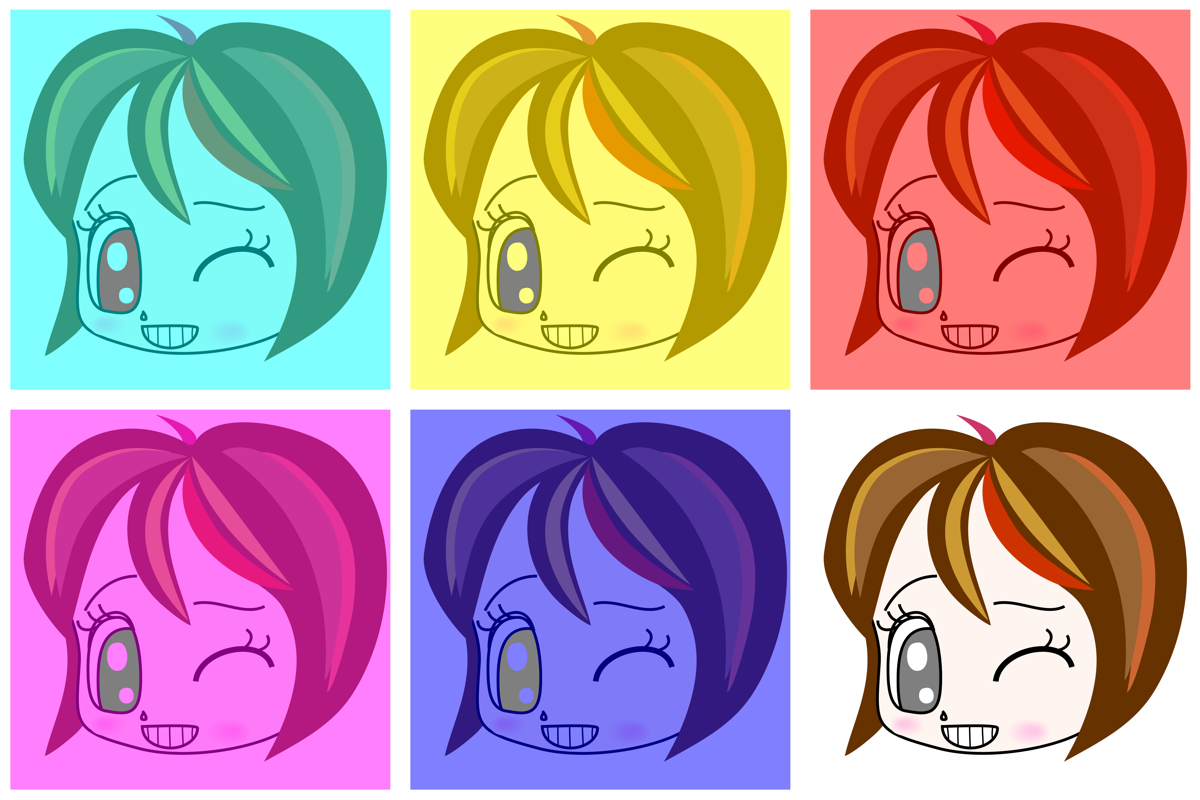
"Eye color constancy illusion 2019"
Each eye appears to be reddish (upper left), bluish (upper middle), light-bluish (upper right), greenish (lower left), or yellowish (upper middle), though the color is nearly the same gray as the one in the lower-right face.
Copyright Akiyoshi Kitaoka 2019 (August 21)
Let's make color illusion works.
Color illusion represented in the form of spatial color mixing
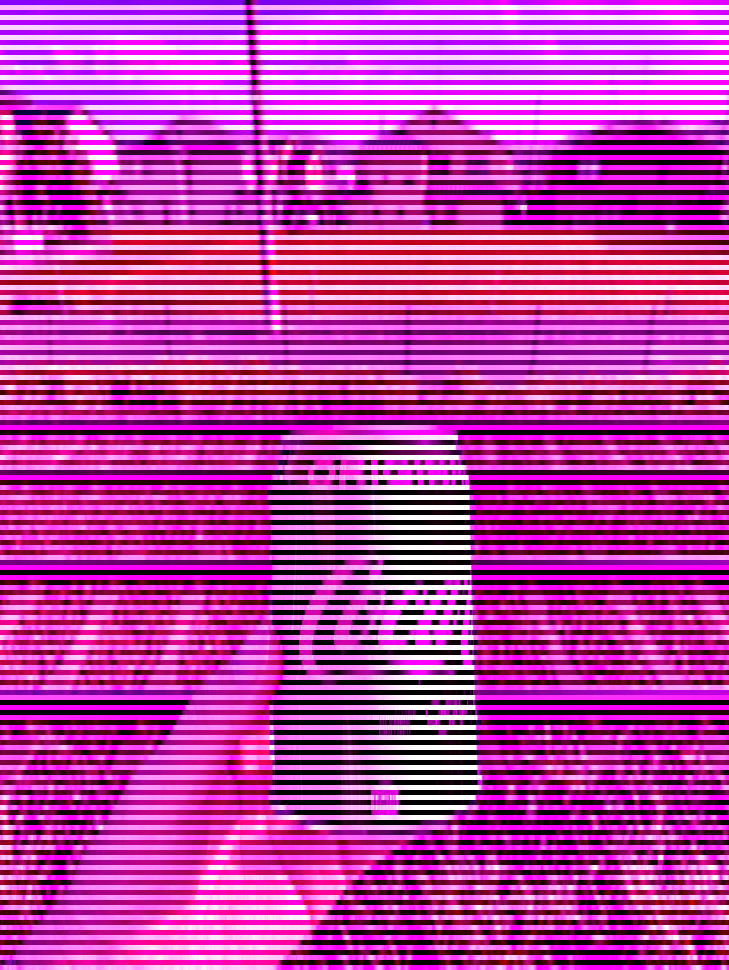
"Illusory grerenish coke can"
Eyes appear to be chromatic, though they consist of black and white stripes.
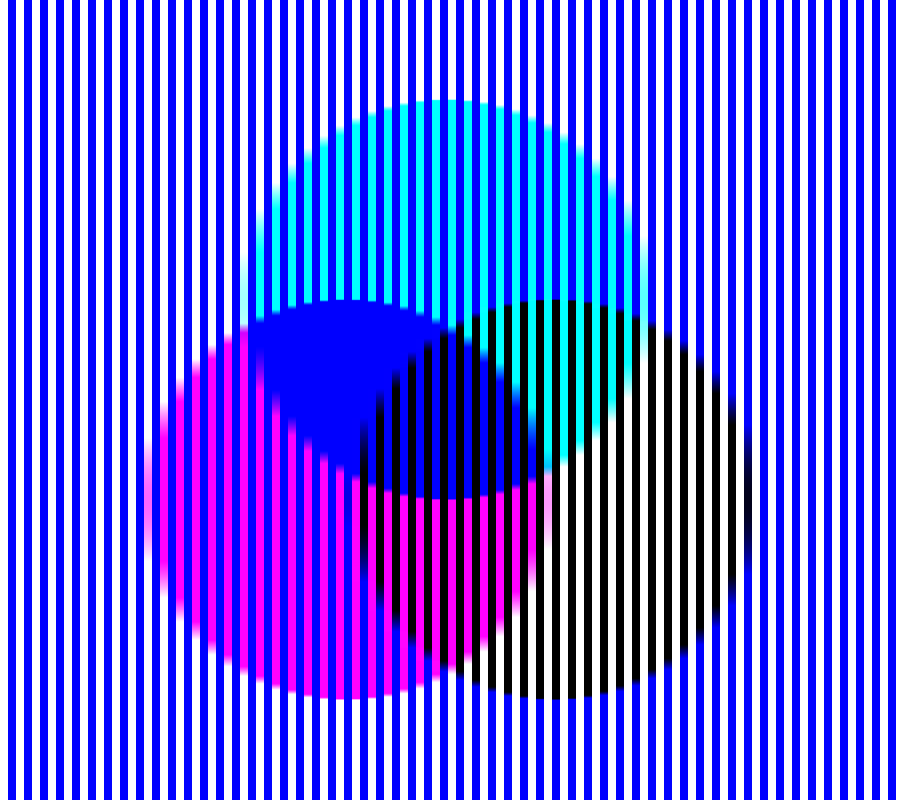
"Illusory yellow"
The area of illusory yellow consists of black and white stripes.
Copyright Akiyoshi Kitaoka 2021 (June 12)
Let's make color illusion works.
On-line color illusion maker 2
More info
Kitaoka, A. (2023). Spatial color mixing and color illusions. (March 4, 2023, 10:05-10:55, The 4th International Symposium 2023 by the International Research Center for Color Science and Art, Tokyo Polytechnic University) --- Presentation (html) --- Abstract --- PDF (manuscript)
4. Shape constancy and depth illusions
Shape constancy is a perceptual phenomenon that refers to the ability of our visual system to perceive and recognize objects as having a consistent shape, despite changes in their orientation or perspective. Specifically, an ellipse appears to be a circle tilted in the depth direction. Moreover, a quadrilateral appears to be a rectangle tilted in the depth direction.
An ellipse appear to be a circle tilted in the depth direction.
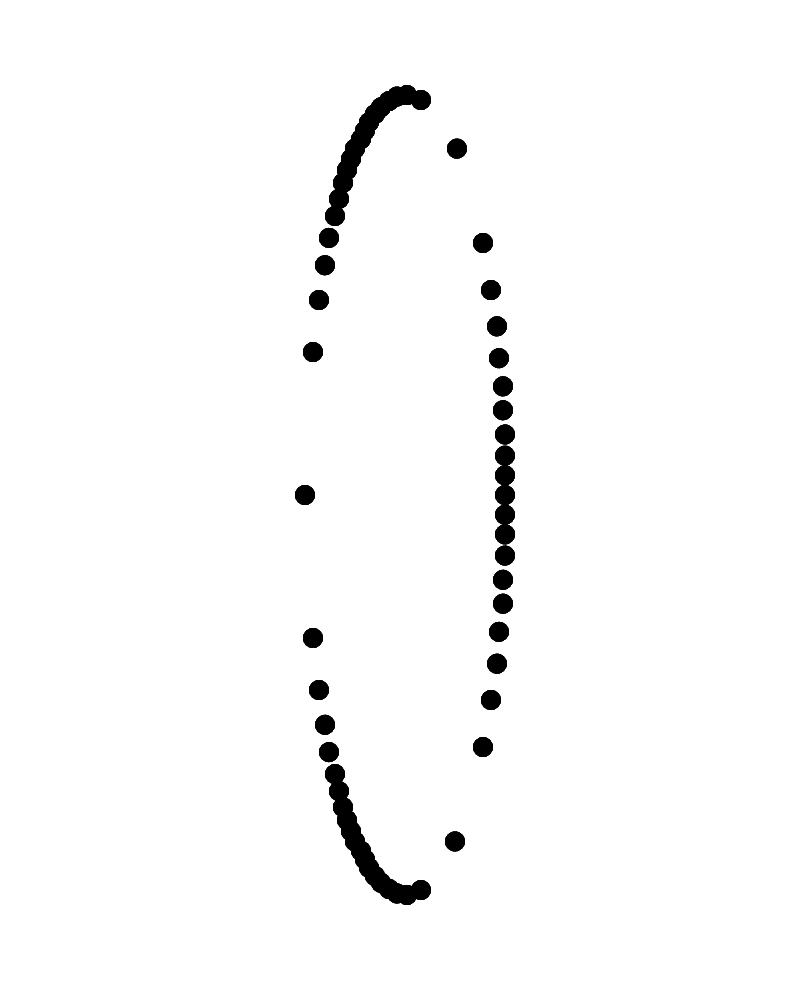
a depth-reversible image
Dots appear to rotate in a circular orbit tilted toward the depth direction rather than an elliptical orbit on a plane perpendicular to the line of sight. The plane of rotation alternates between being perceived as viewed from the left side of the plane and being perceived as viewed from the right side of the plane.
Copyright Akiyoshi Kitaoka 2023 (July 13)
Quadrilaterals appear to be rectangles tilted in the depth direction.
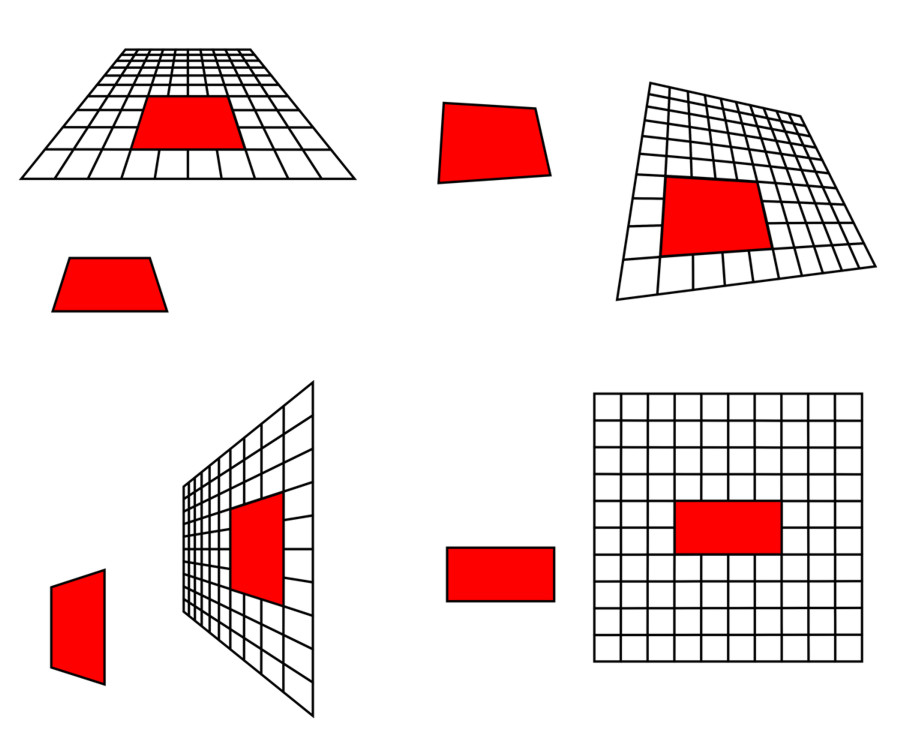
ATTN: A rectangle appears to be a rectangle placed on a plane perpendicular to the line of sight.
Ames room
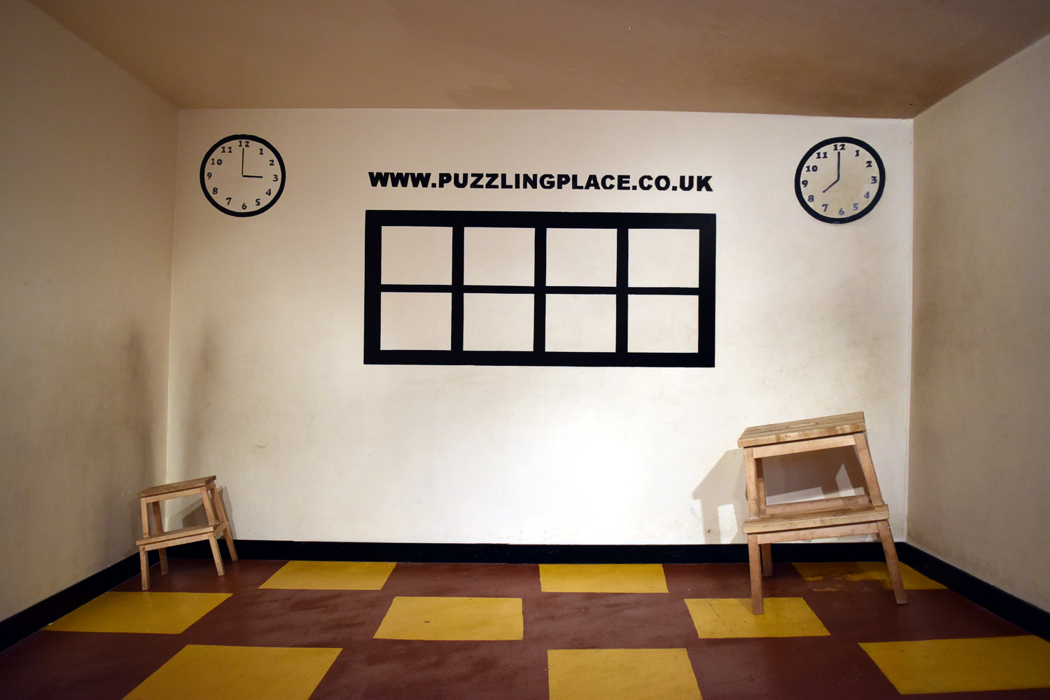
1. The left chair appears to be smaller than the right one, though they are actually the same size.
2. In fact, the left chair is farther away than the right one.
3. However, the front wall is actually distorted in shape, but from this viewpoint it appears to be rectangular.
4. Thus, the wall appears to be perpendicular to the line of sight.
Click the image, then a high-resolution file is downloaded.
The betafumi (fully stepping on the gas pedal) slope
(Matsue, Shimane, Japan)

This slope appears to be steep, but it is 6.1% (3.49゜).
Copyright Akiyoshi Kitaoka 2017 (September 8)
http://www.psy.ritsumei.ac.jp/~akitaoka/saka26e.html

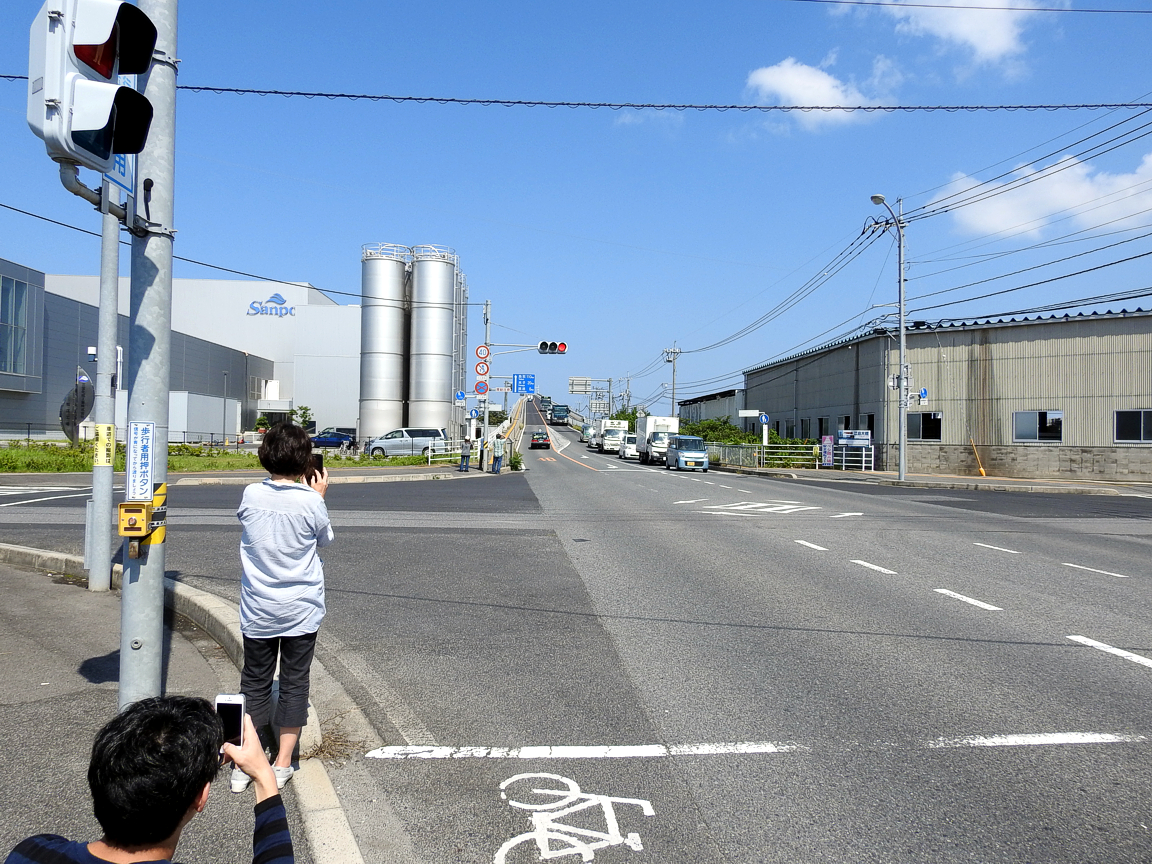
Sightseeing people take pictures.
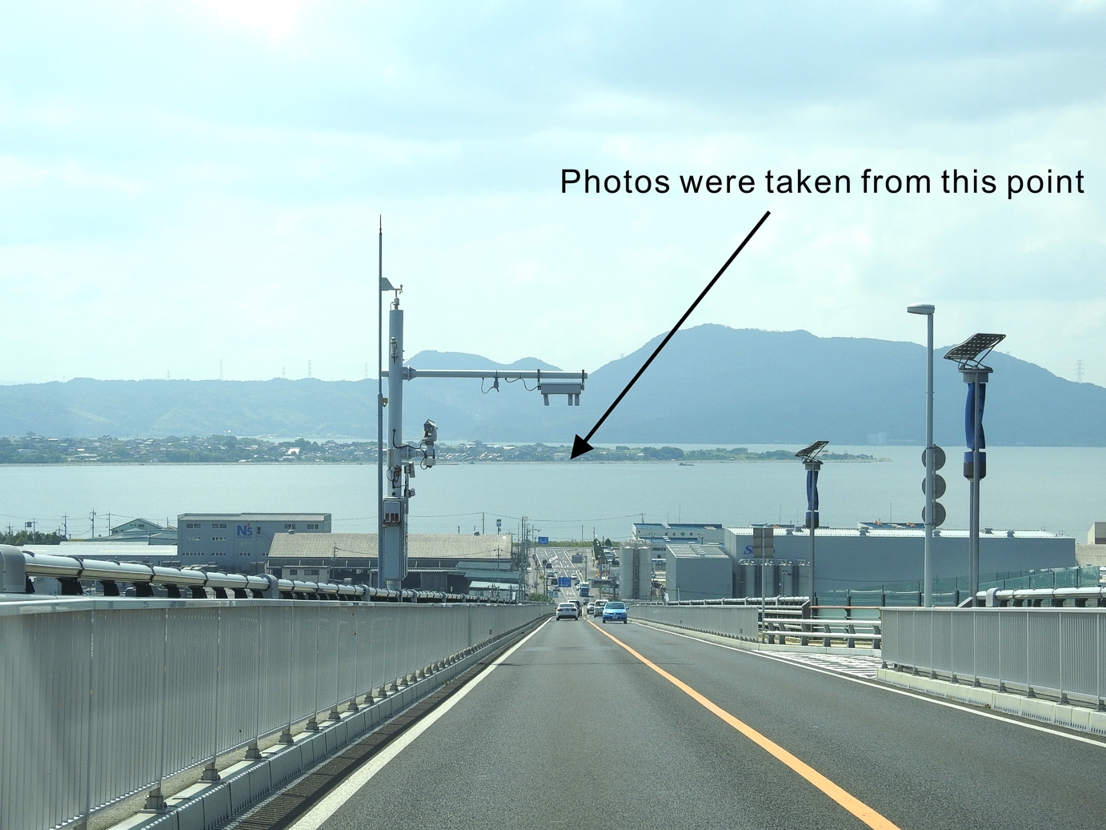
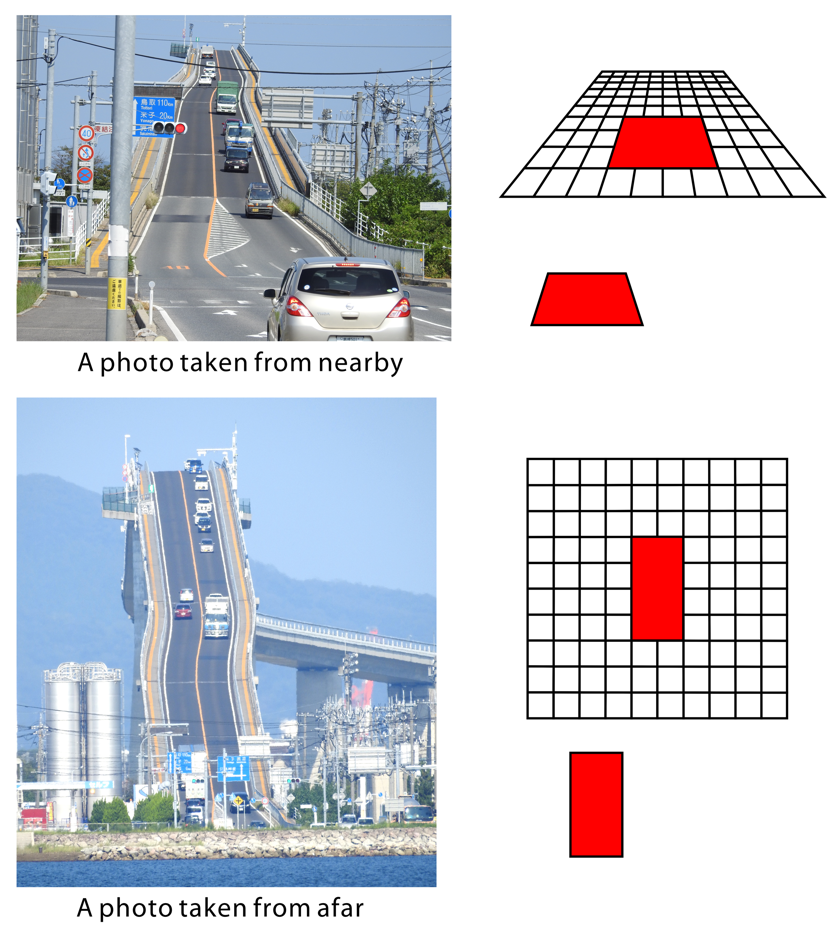
When photographed with a telephoto, the shape of an ascent is closer to a rectangle, and the slope appears to be steep due to shape constancy.
6. Q & A
Q1: Do you have any useful illusions?
A: How about this? This is a viewpoint-free image hump.
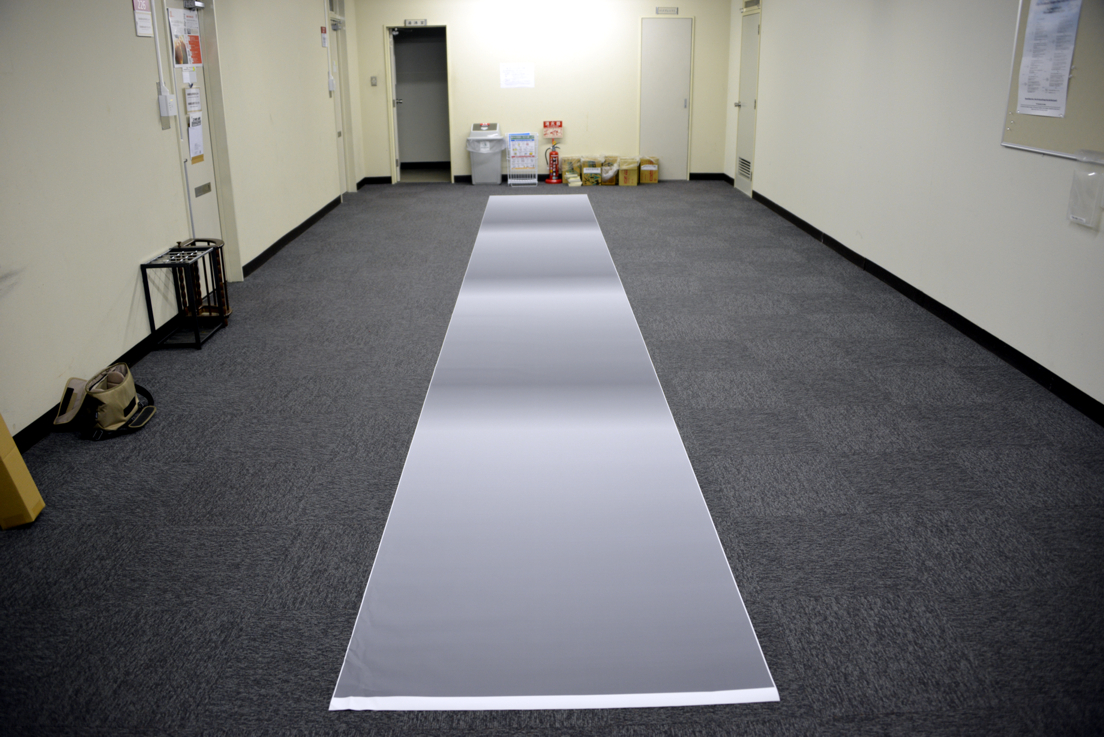
Copyright Akiyoshi Kitaoka 2018 (March 8)
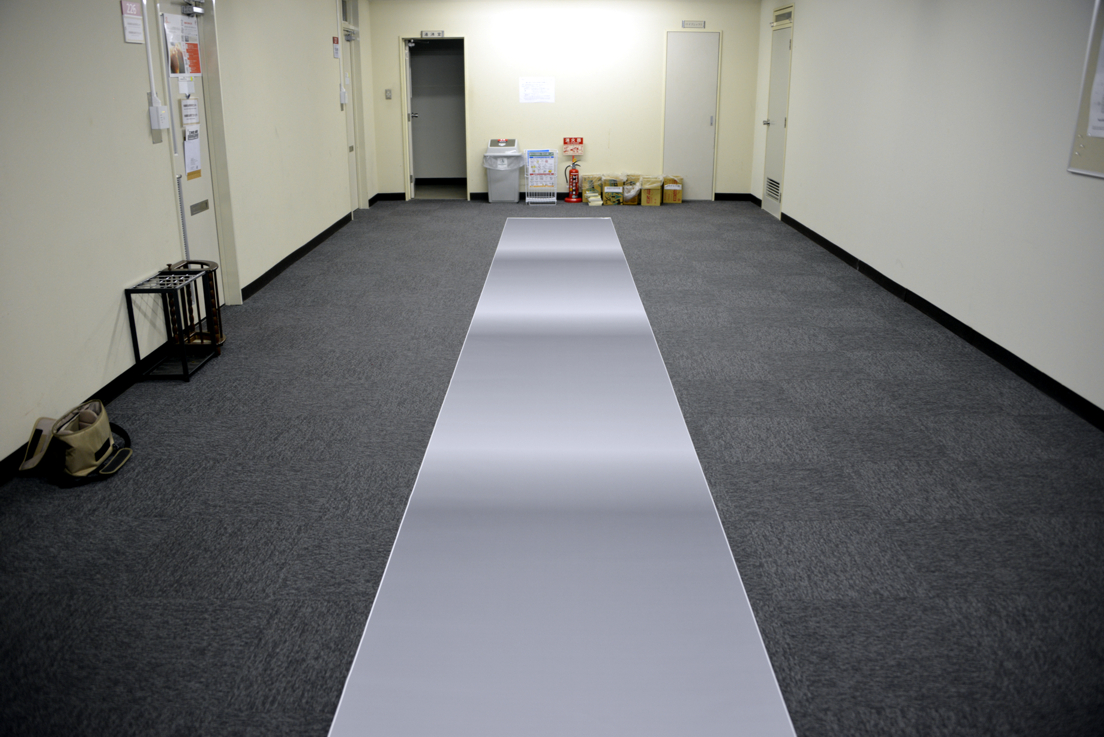
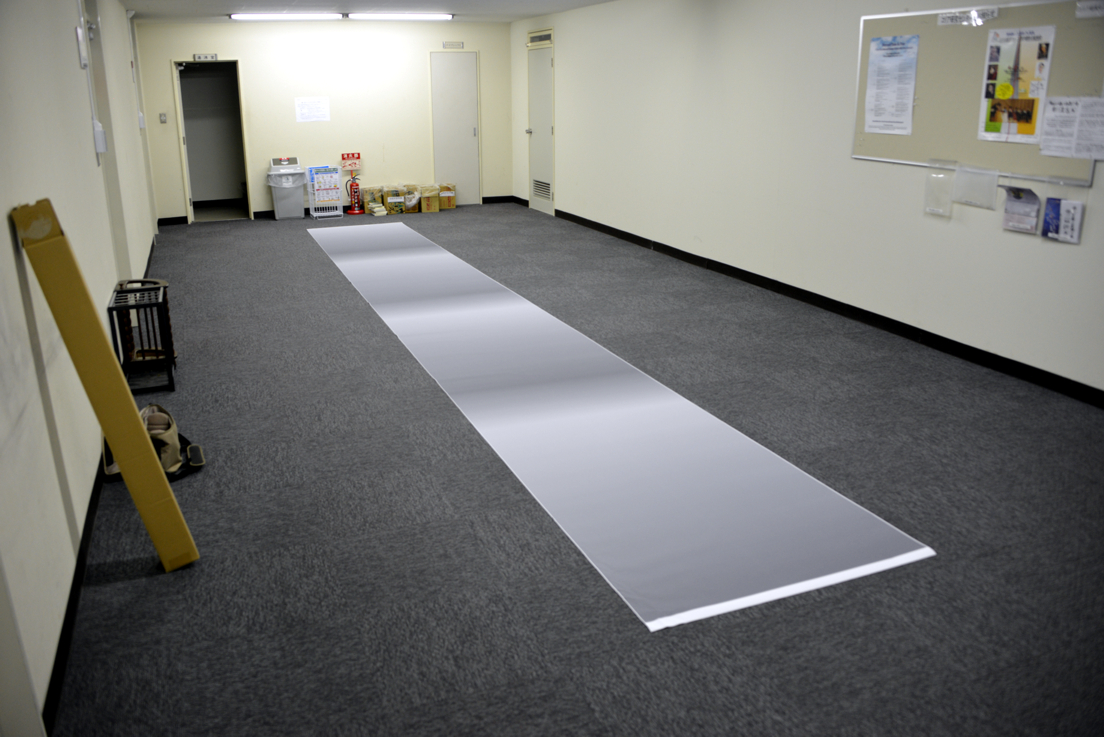
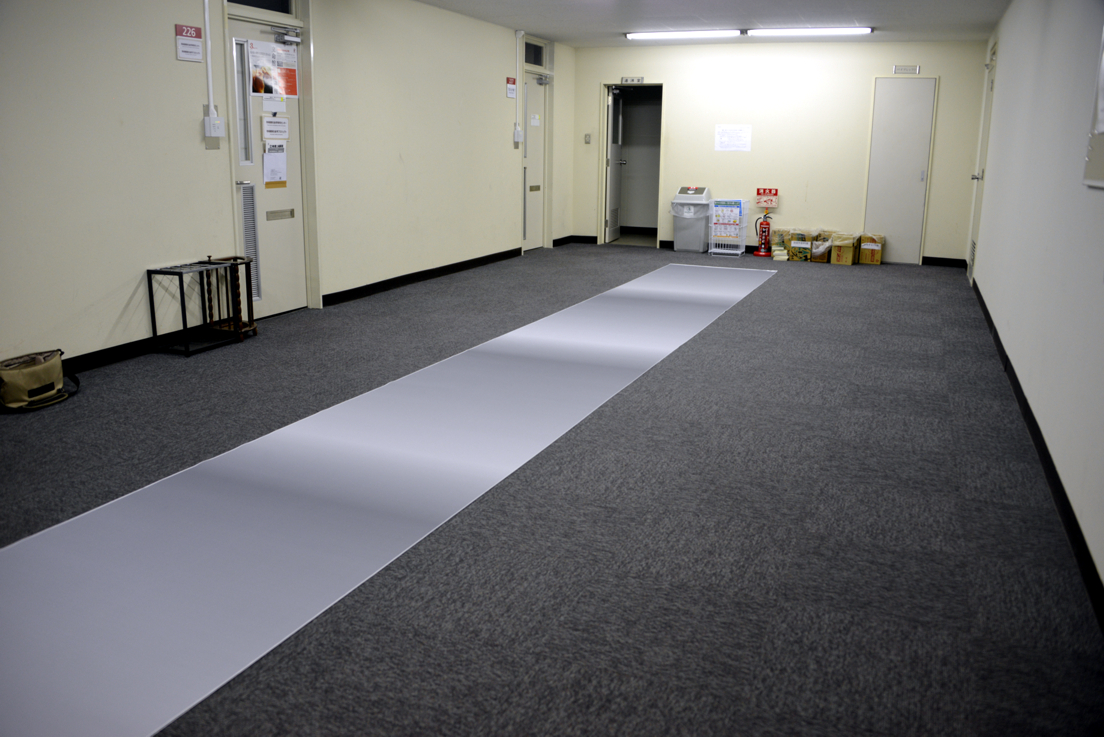

The stimulus is so simple.
I have tried to promotel the product to some of the Japanese police departments
that are in charge of traffic administration, but so far I have not been
successful.
Q2: Why do you study visual illusions?
A2: It is because I believe that the study of visual illusions can largely contribute to the study of vision.
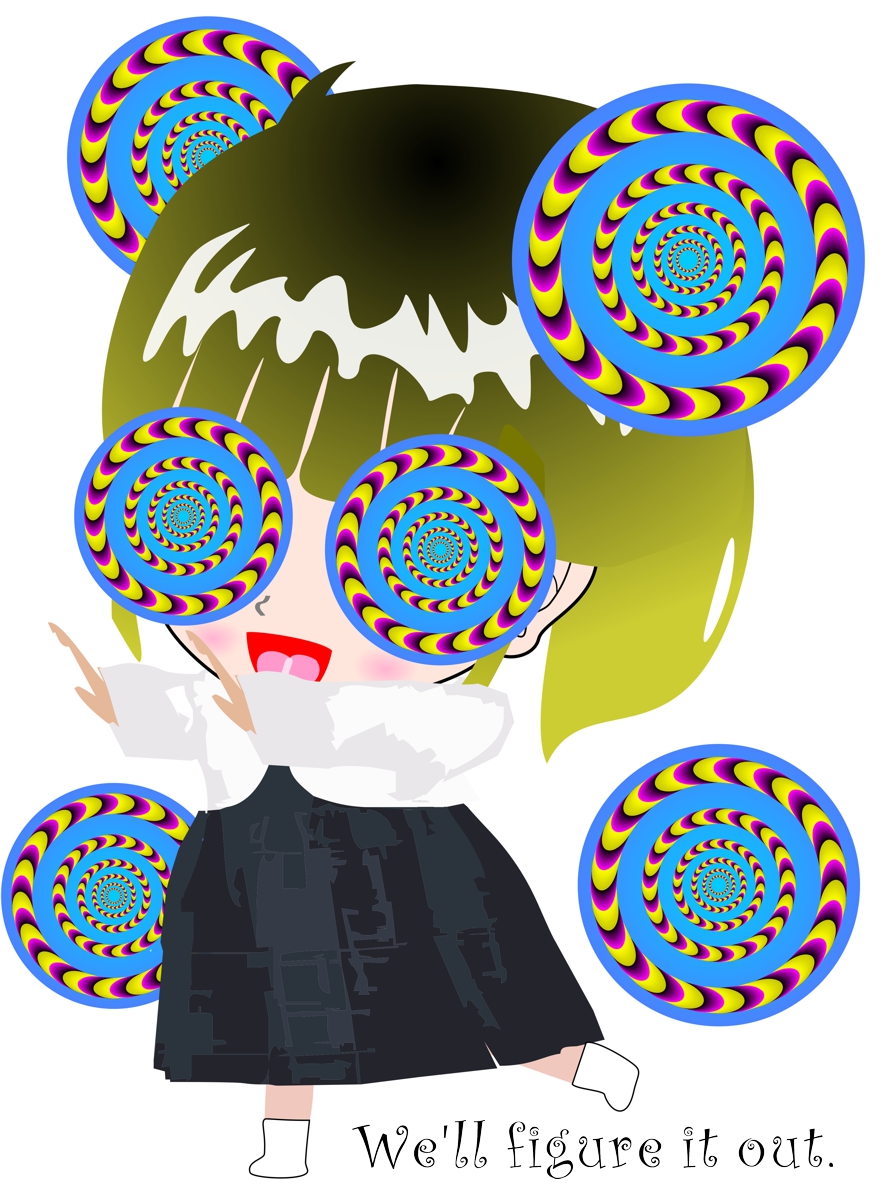
Q3: What would you recommend for studying visual illusions?
A3: It is actually a difficult question. How about this?
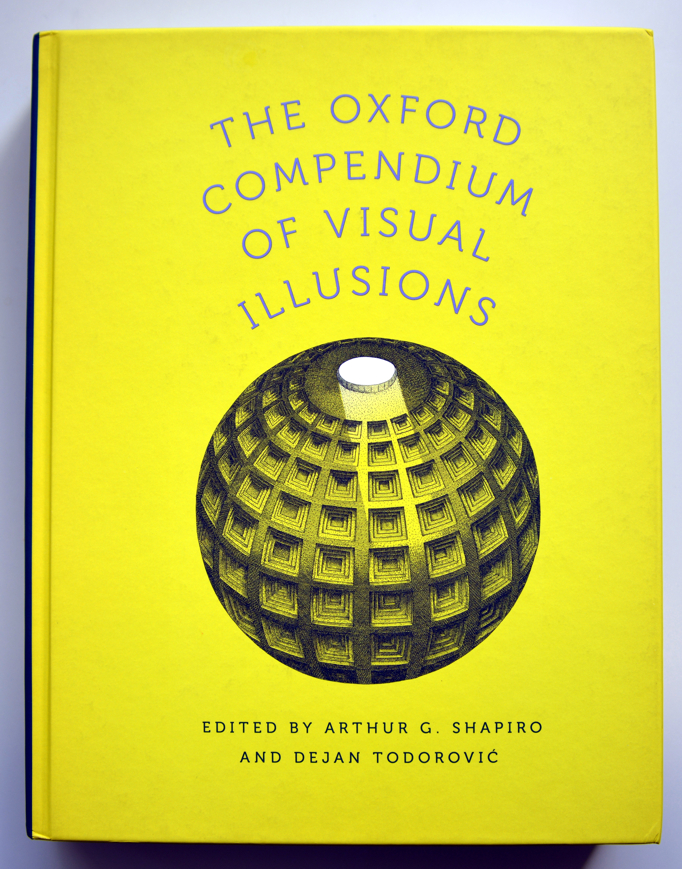
The Oxford Compendium of Visual Illusions
Arthur G. Shapiro and Dejan Todorovic
Q4: How do you make illusion works?
A4: Using graphic softwares (CorelDRAW) or programming (JavaScript)
e.g. How to make "Rotating snakes" using a graphic software

Q5: How do you explain the Dress?
A5: I believe it is basically a color illusion as shown in the figure below.
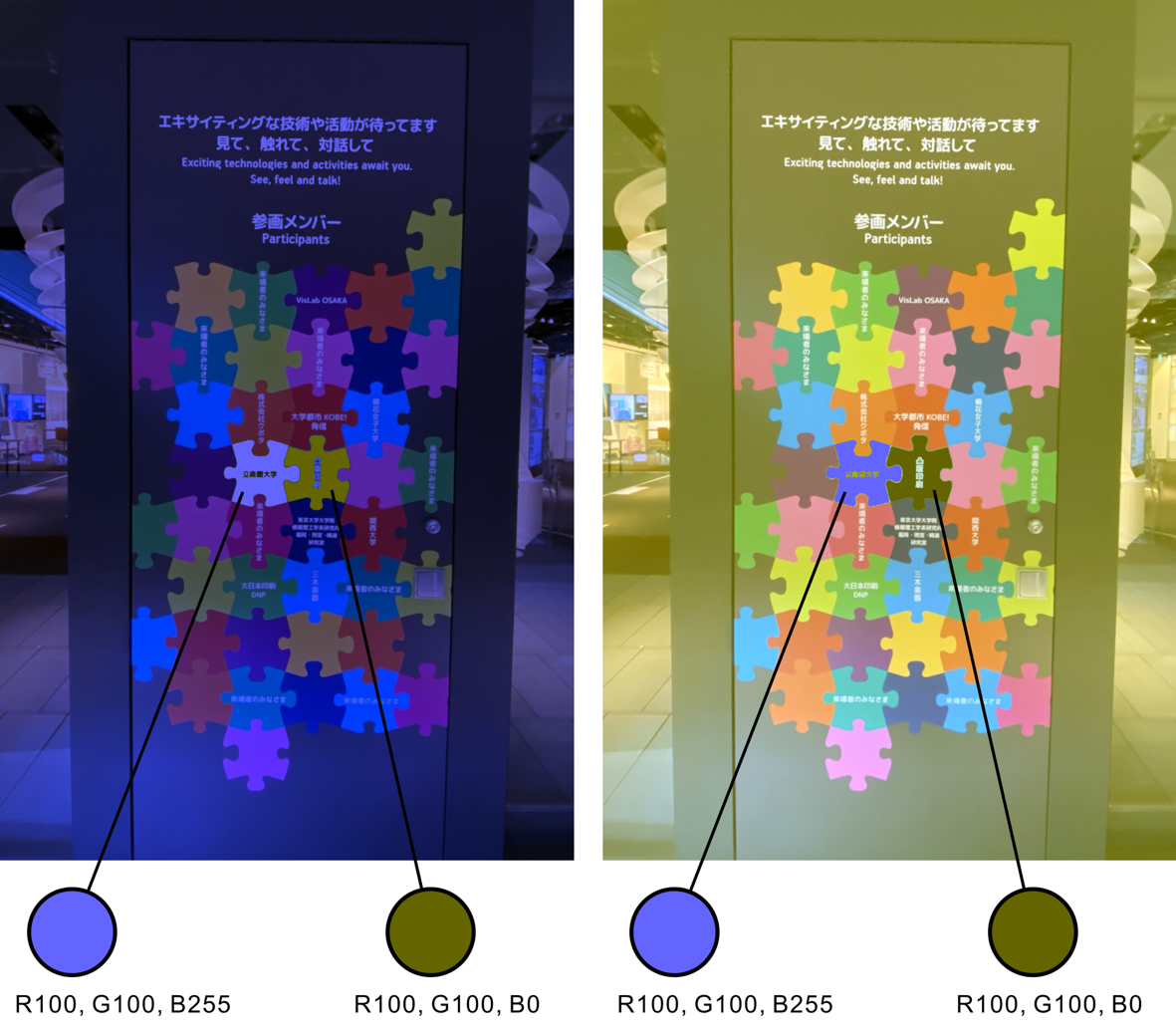
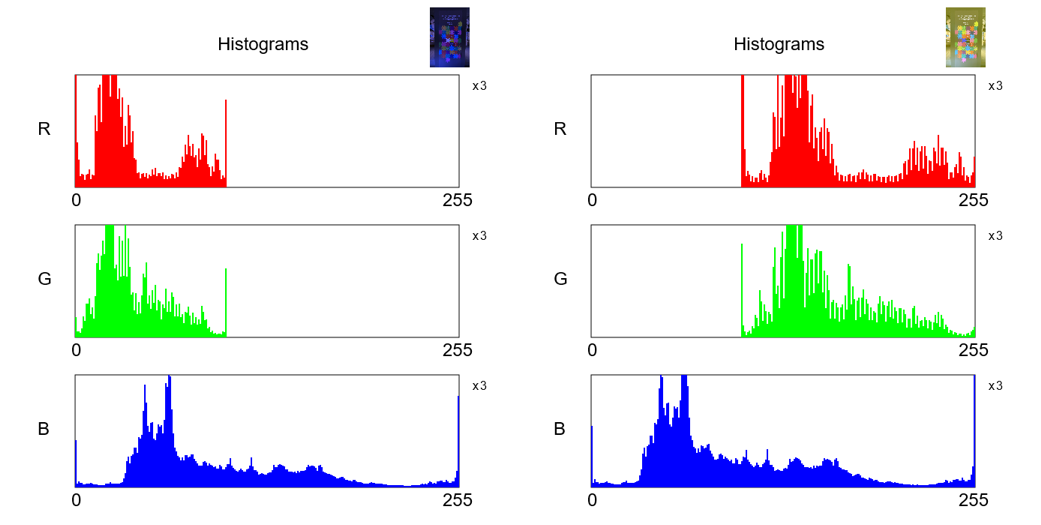
↓
histogram equlization
↓
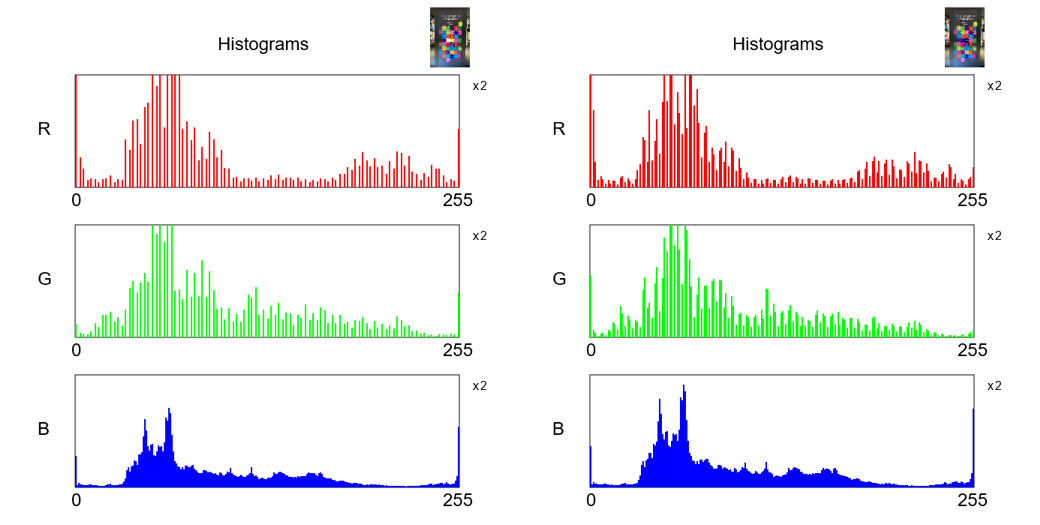
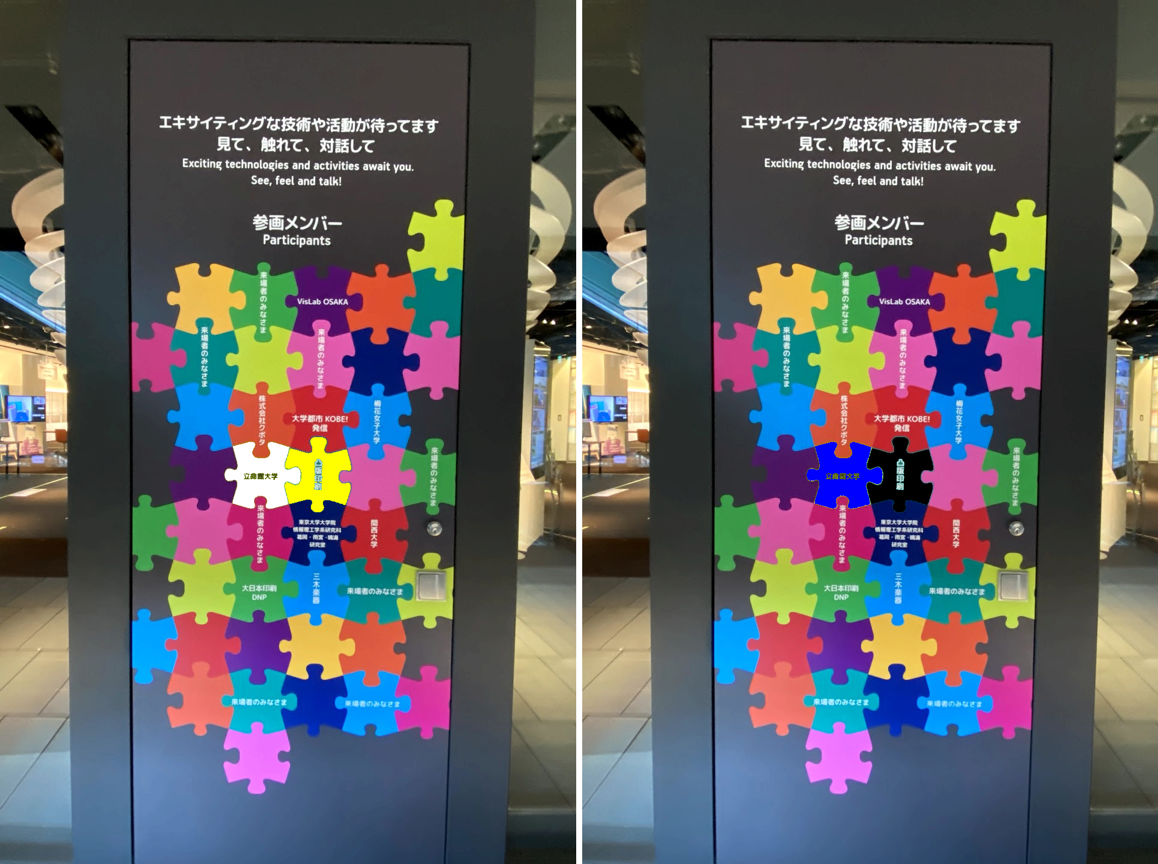
Q6: How to make a hidden image?
A6: The principle is simple. Use the program below.
Let's make hidden images.
